
FREE! VOLUME 41, #2 APRIL 2024 INSIDE: SPECIAL NEEDS - Pull Out and Save! Baby Having a 20+ Summer Camps












April 12th






April 22nd











April
April 26th
April 28th




Celebrate these FUN DAYS during the month of
2nd Children’s Book Day
April
8th Zoo Lover’s Day
Peanut Butter & Jelly Day
April 2nd
Grilled Cheese Sandwich Day
Earth Day
Pretzel Day
Superhero Day
National Pet Day Akron, NY sleepyhollowcamp.com 716.542.4336 To enter online, visit www.wnyfamilymagazine.com YES! Enter Us In “SHREK: THE MUSICAL” Drawing! (ONE entry per family/address. No photocopies accepted. No purchase necessary.) NAME __________________________________________________________________ STREET ________________________________________________________________ CITY _______________________________ STATE ________ ZIP ______________ PHONE __________________________ Kids ages: _____________________________ If you would like to receive our FREE Digital Issue, please provide your email (optional). Email: __________________________________________________________________ MAIL ENTRY to: WNY Family, PO Box 1573, Buffalo, NY 14225 ENTER TO WIN One lucky family will win a Family 4-pack of tickets to see SHREK: THE MUSICAL On stage at Shea’s Performing Arts Center from May 16-19! ENTRY DEADLINE: Thursday, April 25.
April 11th
Paul
Paul
Karen Wawszczyk
MAGAZINE LAYOUT/DESIGN
Michelle Richter
ONLINE
Michele
Barbara Blackburn
Shannon Carpenter •



•
19
MAILING
Want You to Know
• Building Social Capital is Critical for Strong Relationships, but ADHD Can Get in the Way
• Breaking the Code
• What Parents Need to Know About Special Education Rights
• How to Prepare for Your Child’s IEP Meeting

• Intentional Granparenting Special Needs Grandchildren: How Grandparents Make a Difference
• Concerned About Your Child’s Development?
• Tips for Playdates with Kids with Special Needs


April 2024 WNY Family 3 April 2024 • Volume 41 • Issue 2 To Reach Us: Advertising Department advertising@wnyfamilymagazine.com Calendar Submissions calendar@wnyfamilymagazine.com Subscriptions subscriptions@wnyfamilymagazine.com Editorial Submissions editor@wnyfamilymagazine.com
ADDRESS: P.O. Box 1573 Buffalo, NY 14225 Phone: (716) 836-3486
BY: Commercial Printing Division The Post-Journal, Jamestown CIRCULATION (copies printed): 20,000 © 2024 Western New York Family, Inc. All rights reserved. Reproduction in any form without permission is strictly prohibited. Inclusion of an advertisement does not constitute an endorsement by the publisher. PRINT SUBSCRIPTIONS: MAILED FIRST CLASS, IN AN ENVELOPE SAME DAY ISSUE IS DELIVERED FROM THE PRINTER: $28 one year, $52 two years, $75 three years. Phone & online orders accepted with credit cards. Gift subscriptions available. Single copies & back issues by mail, $2.50. IF YOU MOVE: Missed issues will not be replaced if we do not receive an address change before issue mailing date. WE ARE AN AUDITED PUBLICATION Visit Our Web Site www.wnyfamilymagazine.com /WNYFamily /WNYFamily /WNYFamily
PRINTED
EDITOR/PUBLISHER
M. Kline ADVERTISING SALES
M. Kline
ADVERTISING DESIGN
EVENT
CALENDAR EDITOR
Miller CONTRIBUTORS
•
Donna Phillips
Deborah Williams
Where It’s At! Find this entire issue online at www.wnyfamilymagazine.com You’ll find FREE courtesy copies of WNY Family at all Buffalo area Wegmans and 300 locations including Public Libraries, Doctors’ Offices, Child Care Centers and many of our advertisers. (Look for us INSIDE Wegmans on the racks where newspapers are sold, even though we are still FREE, or in some stores, on the FREE rack in the store foyer.) Having a baby Features: 6 n Great Things to Ask for When You Have a Baby by Rebecca Hastings 8 n Great Podcasts For Expectant Moms by Tanni Haas, Ph.D. 9 n How to Combat Morning Sickness by Cheryl Maguire 12 n Budget-Friendly Childcare: Money-Saving Tips for Parents by Rebecca Hastings 18 n Be Prepared for the End of the School Year Slide by Rebecca Hastings Regulars: 5 n Web Finds / What’s New In The Kid Biz 10 n The Family Pet Preparing for Baby’s Arrival 16 n Dear Teacher by Peggy Gisler & Marge Eberts
n Pick of the Literature by Dr. Donna Phillips 45 n Raising Digital Kids Unboxing Fun and Learning: Crates for Kids! by Mike Daugherty 47 n Family Travel Saratoga Springs by Deborah Williams 50 n The Daddy Track Advice to My Daughter by Shannon Carpenter 51 n Parent Previews by Kirsten Hawkes 52 n Tweens and Teens The Summer After He Turns 16 by Katy M. Clark 53 n Single Parenting A Fresh Start by Meagan Ruffing 54 n Family Flavors Cook with Heart Health in Mind 55 n The Kiddie Gourmet Wingnutz Bar & Grill by Barbara Blackburn Directories: 14 n Choosing Childcare 40 n Summer Camps
Mike Daugherty • Meagan Ruffing
17
n SPECIAL NEEDS A Special Pull-Out Section
4
Disabilities
Things Moms of Kids with Invisible



























































4 WNY Family April 2024
web.finds
April 22nd is Earth Day! First celebrated in 1970, this is a day to honor our planet and a reminder to do what we can to make the earth a happier and healthier place for generations to come. Here are some fun activities you can do with your children to inspire them to make a difference!
Flower Garden Seed Bombs
What’s New... IN THE KIDBIZ
GET READY FOR THE APRIL 8TH ECLIPSE!
The grandmothers over at This Grandma is Fun have come up with these seed bombs that are super easy to make. All you need are pieces of construction paper, flower seeds, a food processor or blender, scissors, and water! Simply cut construction paper into 1-inch squares and soak them in water for 20 minutes. Then, after wringing out about half the water, place the paper squares into a food processor or blender and pulse until the paper becomes pulpy. Return the paper to a bowl, sprinkle your favorite flower seeds into them, form into a ball, and dry overnight. Then plant the bombs wherever you would like a splash of color in your yard! Find step by step instructions at hisgrandmaisfun.com/flower-garden-seed-bombs/.
Birdseed Ornament
If your child is a bird watcher, this homemade birdseed ornament is sure to bring lots of feathered friends to your backyard! Melissa at Fireflies & Mud Pies has a simple recipe that uses just three ingredients –unflavored gelatin, boiling water, and birdseed. Using cookie cutters, you and your kids can make ornaments of many fun shapes and sizes. After drying and setting for 24 hours, simply hang them up outside and watch the birds flock to your yard! Head to firefliesandmudpies.com/birdseed-ornaments/ for the complete recipe.
Plastic Lid Ladybugs
This fun craft, courtesy of Crafts by Amanda, will not only bring out your child’s creative side, but it will also teach them about recycling and repurposing things in unique ways. All you will need is a plastic lid from a milk or juice jar, some black acrylic paint, googly eyes, a paintbrush, and white craft glue. You can find full directions at craftsbyamanda.com/plasticlid-ladybugs/.
Glitter Mosaic Earth Day Sign Craft Kit
We found this cute craft kit on Amazon. It comes with enough supplies, individually pre-packaged, to make 12 of these Earth Day signs, making it a great group activity for your child and their friends. Each Earthshaped sign shimmers and shines with glitter when finished and comes printed with a big heart that reads “Love the Earth”. (Amazon, $18.99)

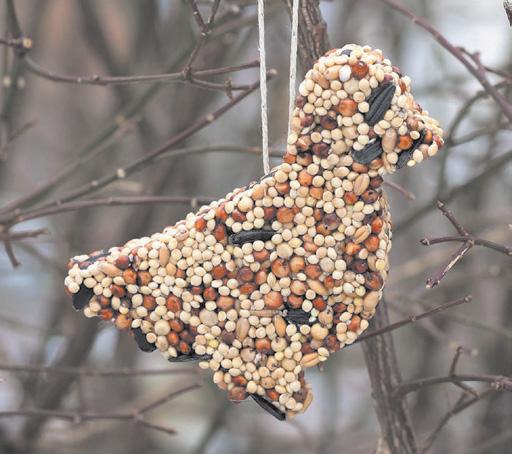


On April 8, 2024, Western New York will experience one of nature’s most spectacular phenomena: a total solar eclipse. The Sun and Moon will align over WNY, encompassing the region in the Moon’s shadow as it travels across the Earth’s surface. This nearly 100-mile-wide shadow is also called the path of totality.
During totality, the period when the Moon completely blocks out the Sun, areas along the path will experience darkness for a few minutes. In WNY, totality will occur around 3:15 p.m. and last for just over three minutes for those along the path. If skies are clear, the Sun’s swirling atmosphere, the corona, will be visible.
In the hour before and after totality, with proper solar filters, the Moon’s silhouette will be visible as it travels across the Sun. It’s NEVER safe to look at the Sun’s rays with the naked eye! Doing so can cause permanent damage to your eyes and/or vision. The only safe way to directly view the Sun is through specialized solar filters. The only exception to this is during the few minutes of totality when it is safe to view the corona with your naked eye.
The eclipse can be viewed from anywhere in WNY that has a clear view of the southwestern sky, meaning WNYers don’t need to travel far—if at all—to see it. In the days leading up to the eclipse, locate the Sun’s position around 3:15 p.m. If you cannot see the Sun from outside your home or office, consider walking to a nearby park. With an estimated 1 million tourists visiting on April 8, staying at or close to home may save you from lengthy traffic jams. (Consider this for your work commute and childcare needs!)
Contact your local Buffalo & Erie County Public Library and ask if they still have complimentary eclipse glasses. If you’re purchasing them, make sure they comply with ISO 12312-2, the international safety standard for direct solar viewing. Visit https://eclipse. aas.org/eye-safety to learn more from the American Astronomical Society.
Enjoy this experience because the next time WNY will be within the path of totality is 2144!
April 2024 WNY Family 5

It’s no secret being a new parent is hard. The adjustment to caring for a new little one is a lot, and you often do it while feeling more tired than you’ve ever been in your life. So many people offer gifts and help, which is great…if you get something helpful!
You can ask for something from your registry; a cute baby outfit is always fun, and diapers are always appreciated. But there are some things that you’ll appreciate even more than that adorable onesie or extra crib sheet. Instead of crossing your fingers and hoping you get something great, here are some fun and easy ideas that will make your life with a baby better.
ASK FOR SOMETHING DELICIOUS
Finding time to make delicious food is harder than ever with a new little one. You’re going to be busy caring for and loving your new baby. That’s where delicious gifts make a big difference. You can go homemade or suggest an easy-toorder (and enjoy) option.
GoldBelly makes it possible to send everything from bagels to desserts to full meals from across the country right to
Great Things T Ask For When You Have a Baby
— by Rebecca Hastings
someone’s door. Lobster? Check. Cake? They have it. A full holiday meal? Done and delivered. This is a great way to get a meal from someone who can’t bring one themself or to get a taste of your hometown.
If you’re looking for something extra sweet, Sugarwish is the perfect answer. One lovely box and they get to pick what goes inside. From candy to cookies, they cover all the sweet bases. Popcorn and snacks have you covered for savory treats. You can even get a box of treats to keep the family’s furry friends happy! It may seem indulgent to ask for, but the sweet treat may be what you need on those long nights!
If you want something healthy delivered, try Hungry Planet. They offer healthy plant-based foods that taste great. Created by chefs these meat alternatives are perfect for vegetarians and easy to heat and eat.
YOU’LL WANT SOMETHING COZY
Babies get lots of clothes. And it’s only right because they’re cute and they go through a lot of laundry. Parents often end up wearing baby messes too. Plus, you could use a little something to feel
comfortable. A nice pair of pajamas is a great gift, that feels like a luxury. Ask for cozy pajamas or comfy loungewear for those late-night feedings and full days of play and snuggles.
For another luxury, Barefoot Dreams Blankets give a perfect cozy feel when you get the chance for a nap in the middle of the day. This may be a splurge you won’t buy for yourself, but this cozy blanket is a lovely way to feel special when you’re a little bit weary.
DON’T FORGET SOMETHING NECESSARY
Taking care of yourself is harder than ever with a new little one. Ritual helps make it simple with vitamins and protein shakes especially formulated for the postpartum days. Plant-based and specifically formulated, they help with lactation and vitamin needs. Plus, they have daily vitamins to keep dad functioning in tip-top shape too!
Beanbox may be your new best friend. (Other than your little one, of course!) Coffee is delivered right to your door so you never have to go out to get a great cup. They have everything from coffeegrams to give a taste of the tropi-
6 WNY Family April 2024

cal getaway a new parent longs for to subscription boxes that keep them going every month. Plus, they have decaf and tea options so everyone is happy (even if you’re nursing!).
REMEMBER, PEOPLE WANT TO HELP
People really do want to help, but they often don’t know how. All of these gifts are easy for people to send directly to you, making it easier than ever to help new parents feel loved as they take care of their new little one. Never discount the tried-and-true offers of meals and help in the house. It may seem frivolous, but when you get help, you’re able to get rest and enjoy your little one even more. Asking for help, whether in a gift or a load of laundry, isn’t selfish. It’s a great way for people to show you they care.
Rebecca Hastings is a former elementary teacher who traded the classroom for writing when she stayed home with her three children. Passionate about authenticity, faith, and family, you can find her at RebeccaHastings.net and on Amazon. In real life, she can often be found typing words, driving her kids places, or wherever there is chocolate.









April 2024 WNY Family 7
Call: (716) 877-0676 Email: dralaina@juno.com Dr. Alaina Rowswell-Kulikowski Board Certified by ICA Council on Pediatrics 1567 Military Road Kenmore, NY 14217 Helping generations of families pursue optimal health... NATURALLY www.CareConnectionOnline.com Lactation Support, Classes, Breast Pumps & more, covered through insurance. Support your local small business for great shower gifts for mom or baby! NEW address: 1360 North Forest Rd., Suite 111 Williamsville, NY 14221 716-725-6370 insurance. Specializing in ... • Marriage & Relationships • Infidelity • Infertility • Parenting & Coparenting • Grief & Loss • Anxiety & Depression orTelehealth in counselingperson available. You’re NOT alone www.auduboncounseling.com * Groups Forming in 2024 Lynne Rifkin Shine, LMHC CRC 4800 N. French Rd. • East Amherst, NY 14051 716-725-7158 | 716-689-3110 Ext. 1
HEALTH
Great Podcasts for Expectant Moms
— by Tanni Haas, Ph.D.

There are few moments more exhilarating than the moment you realize that you’re pregnant and that you one day will hold a precious little life in your arms. As you seek advice from family and friends on how to make the pregnancy as smooth as possible, consider another great source of information: podcasts produced by experts on pregnancy and childbirth. The thing about podcasts is that you can listen to them whenever you have a spare moment, even when you’re doing other things. Here’s a list of some of the very best podcasts for expectant moms.
All About
Pregnancy & Birth
(Available at: Apple, Audible, Spotify)
You are in good hands with Dr. Nicole Calloway Rankins, the creator and host of All About Pregnancy & Birth. An experienced OB/GYN who has helped deliver more than one thousand babies during her career, she also teaches a pop-
Are you anxious about your upcoming trip to disney?
Find the Mom is an Anxious Traveler Community:

Because your magical vacation can happen, let Missy show you how.
ular, online birthing course. Her podcast is a fascinating mix of research-based advice, pregnancy and childbirth anecdotes recounted by Dr. Rankins and stories of how it is to be pregnant and give birth from moms of all ages.
Birthful
(Available at: Apple, Audible, Spotify)
Adriana Lozada, the creator of Birthful, is another well-known expert on all things pregnancy and birth. A practicing doula for many years, she offers both birthing and post-partum preparation courses online and works as a sleep consultant. On her podcast, she talks with other experts about pregnancy and childbirth. Recent episodes explore topics such as how to decide what type of birth is right for you and how to make it the most enjoyable experience possible.
Informed Pregnancy
(Available at: Apple, Pandora, Spotify)
Another great pregnancy-related podcast is Informed Pregnancy, produced by Dr. Elliott Berlin, a prenatal and postpartum chiropractor in private practice who also teaches various workshops for expectant and new moms. In line with his expertise as a chiropractor, many of the episodes focus on such topics as how best to stay fit during and after pregnancy, including how to maintain a firm and strong pelvic floor and how yoga can enhance your overall wellbeing.
Pregnancy Pearls
(Available at: Apple, Audible, Spotify)
Like Dr. Rankins, Dr. Nicole Plenty is a well-known physician. In fact, she’s double board-certified as an OB/GYN and a Maternal-Fetal Medicine Specialist which, in lay terms, means that she’s an expert on high-risk pregnancies. On her podcast, Pregnancy Pearls, Dr. Rankins educates women about various risk factors and how you can ask expert physicians to deal with them, including asthma, diabetes, hypothyroidism, and preeclampsia, among other medical issues.
Pregnancy and Birth Made Easy
(Available at: Apple, Audible, Spotify)
Finally, take a listen to Pregnancy and Birth Made Easy, by Cortney Hart and Stephanie King, two experienced doulas and childbirth educators who offer pregnancy and postpartum courses. A particularly useful feature of their podcast is the frequent episodes titled “Birth Stories.” During these episodes, many of the women Courtney and Stephanie have worked with discuss their pregnancy experiences and what they did to make their journeys as enjoyable as could be.
Tanni Haas, Ph.D. is a Professor in the Department of Communication Arts, Sciences, and Disorders at The City University of New York – Brooklyn College
8 WNY Family April 2024
— by Cheryl Maguire

How to Combat Morning Sickness
Are you feeling nausea during your pregnancy? If so, I feel your pain. It has been over ten years since I was pregnant, but I still remember that awful queasy feeling. During my first pregnancy with twins, I experienced morning sickness all day. In fact, I felt the sickest at night time. During my second pregnancy with a single baby, I thought I would feel better especially since I knew what to expect and I was only having one baby. But it was worse, much worse. Chasing after toddler twins only left me feeling more nauseous. During both pregnancies, I had morning sickness until I reached my sixth month of pregnancy.
According to biologist Margie Profet, morning sickness is an evolutionary adaptation, which defends a fetus from natural contaminants. Studies have shown that women who experience morning sickness are less likely to miscarry.
The American Pregnancy Association found that most women experience morning sickness from the 6th week to the 12th week. More than 50% of pregnant women have some form of nausea due to the increase in the pregnancy hormone human chorionic gonadotropin (HCG).
Nothing I did cured my morning sickness but these remedies helped me to feel better even if only for a short while. Before you try any of these methods, you should discuss it with your doctor.
Eat When You First Wake Up: I always had a box of crackers on my nightstand. Before I got out of bed, I would eat a few crackers. An empty stomach can increase nausea due to stomach acid, so eating even a few crackers will help decrease the feeling. It also helps throughout the day to eat small snacks to make sure your stomach is never empty.
Lemonade: Lemon is an alkaline that reduces irritation in your stomach. Some people also find the smell of lemons reduces nausea. I don’t like lemonade but I was willing to try anything and I did notice some relief after drinking it.
Ginger: Ginger is a spice that has a calming effect on your stomach since it promotes the secretion of digestive enzymes that help neutralize stomach acid. It also contains phenols that relax stomach muscles. You can sprinkle it on your food or try drinking Ginger Ale, but make sure it states “made with real ginger” on the bottle. Ginger candy or capsules are also available.
Chewing Gum: For me, chewing gum was the most effective method in helping me to feel better, especially since I could
chew gum all day long (whereas I couldn’t drink lemonade all day). Similar to ginger, chewing gum causes you to produce extra saliva which neutralizes stomach acidity. Peppermint or spearmint gum will aid nausea symptoms since it contains menthol which has an antispasmodic effect relieving indigestion.
Lie Down: It may be difficult to lie down, especially if you are caring for other children or you are at work, but sometimes it is the only way to feel better. I found motion (as simple as walking) could cause my morning sickness to get worse, so lying down would help settle my stomach. Deep breathing while lying down can calm both your mind and abdomen.
B6 Vitamin: A study by Dr. Jennifer Niebyl found that taking 25 mg of B-6 three times a day helped women cope with morning sickness. I used this vitamin which helped me to feel better.
When will I feel better?
Even if you have morning sickness during your entire pregnancy, once the baby is born it will all be forgotten and worth all the suffering. Until of course, someone mentions their morning sickness and you can’t help but feel a little queasy yourself.
Cheryl Maguire holds a Master of Counseling Psychology degree. She is married and is the mother of twins and a daughter. Her writing has been published in The New York Times, Parents Magazine, AARP, Healthline, Your Teen Magazine, and many other publications. She is a professional member of ASJA. You can find her at X @CherylMaguire05

April 2024 WNY Family 9
Also specializing in: • Webster Technique for Pregnancy • Children • Athletic Injuries • Auto/Work Injuries • Graston Technique • Flexion/Distraction Technique General Family Practice Call for an appointment Dr. David Lewis ~ Dr. Emily Patrick ~ Dr. John Rockas ~ Dr. Jessica Carrick 716-633-2036 | www.MainChiropractor.com 4440 Shimerville Rd., Clarence, NY 14031 Clarence Chiropractic
 — Courtesy of the Niagara Frontier Veterinary Society
— Courtesy of the Niagara Frontier Veterinary Society
There are plenty of things to consider when bringing home a new baby, and safety is at the top of that list. Having pets at home poses some risks to your new baby but, with planning and preparation, bringing home a new baby can be a smooth transition for everyone, including your furry family members.
You’ll want to use the duration of pregnancy to prep your cat or dog for the baby’s arrival. The ASPCA suggests enrolling your dog in basic obedience

Preparing for Baby’s Arrival

classes and making sure your cat’s litter boxes are in quiet areas. Be sure pregnant women avoid cleaning the litter box (and gardening) or wear gloves and wash their hands to minimize the risk of Toxoplasmosis. Dogs that learn to be obedient will listen better and are more easily controlled. Set up nursery furniture as soon as possible so that pets can become accustomed to new arrangements. However, if you plan to keep cats out of baby’s crib, do not allow them to nap there before baby arrives.
Newborns are noisy. After all, the only way they can convey discomfort, hunger, sadness, or exhaustion is by crying. Dogs and cats can become distressed, frustrated, and agitated. To avoid this, the ASPCA recommends introducing common sounds to your pet prior to the baby’s arrival. Expose your pets to the sound of a baby crying. If you don’t happen to have a baby available to assist you with this, turn to the internet to access recordings of babies crying. A crying baby is very loud and can be scary for pets who have never experienced that sound. Start by playing the sound softly while feeding your pet, then gradually increase the volume played during meals until your pet can eat calmly despite crying at full blast.
for her, especially if she’s been the “only child” for a while.
Some pets have never been around children before. Little people do unpredictable things that adults don’t, like make sudden movements, shriek, and get in pets’ faces. To give your pet exposure to tots, take your dog to the park to see how he reacts to children from a distance. Ask mom friends to come over with their kids and if you may walk near them when they have their kiddo in a stroller—or, if things go well, even alongside them. Set up your own stroller and take walks with your dog and the empty stroller to get used to it before baby comes. These tactics will help your pet gradually acclimate to the sight and sound of children.
Plan ahead if you will need a pet sitter while mom is in the hospital for the delivery. You may want to make arrangements for pets to be out of the house for the first week or two so you can focus on the newborn.
Pets read your body language and your pheromones. If you are anxious and worried about your pet’s reaction to the baby, you may inadvertently be encouraging that anxiety. Picture your pet and baby being calm together. Try to find a happy medium between vigilance and stress. Practice breathing normally and not holding your breath when the two are in the room together. Long slow exhales and slow blinks can soothe all species!
You can’t expect a finished product right out of the gate. Plan out your encounters between pet and child – no matter what the age – and start in lower stress situations like a quiet familiar www.NFveterinarysociety.org
When you bring the new baby home, your dog will encounter many new sights, sounds and smells. She may find some of them upsetting, especially if she didn’t have opportunities to spend time with children as a puppy. You’ll change your daily routine, so your pet’s schedule will change, too. And, out of necessity, she’ll get less of your time and attention. It may be a difficult time
10 WNY Family April 2024
THE FAMILY PET
room. Try to create tiny successes and build from there. Allow the pet to welcome the new mother first, and make sure the baby and pet meet in a quiet familiar place. Consider calming pheromones for pets such as Feliway and Adaptil.
Your dog’s crate should be their sanctuary, a space that is just theirs and off-limits to kids. If you have babysitters, nannies, or visiting relatives who take on dog care as part of their household helping, you can’t rely on them to be as vigilant as you would be. In those cases, a snap-lock on the crate with a note — “Don’t let out!” — reminds them in your absence. Babies come with many tempting items like dirty diapers and pacifiers that dogs may eat which could become lodged in their intestines. Crating can keep everyone safe when unable to fully supervise.
Make special time for your pet. Set a timer for five or ten minutes every day at roughly the same time to do one of your pet’s favorite activities, even if that’s just snuggling on the couch. Provide plenty of enrichment for your pet such as food puzzle toys, toys that activate automatically, cat towers, cat nip, and multiple beds to rest on. Talk to





your veterinarian if you think your pet might benefit from a calming medication or supplement to help cope with all the changes, and make sure your pet has been dewormed recently so they don’t pass any parasites on to the baby. Wash your hands between handling your pet and your new baby. Avoid raw pet diets which may increase the risk of bacterial infections which mom and baby would be at higher risk of getting.
The main thing we all want is everyone to be safe and get a turn for attention. And, when distracted or in doubt, separate pet and child. It’s important to remember that you can provide

both your pets and your child with the love they both need, but not necessarily in the same place at the same time. Remember to carve out a few moments just for you as well!
The Niagara Frontier Veterinary Society is a 501(c)3 organization comprised of more than 75 small animal hospitals and more than 225 practitioners in Erie and Niagara Counties. It exists to advance public awareness and understanding of appropriate and compassionate pet health care, veterinary services and the veterinary profession.














































April 2024 WNY Family 11
— by Rebecca Hastings
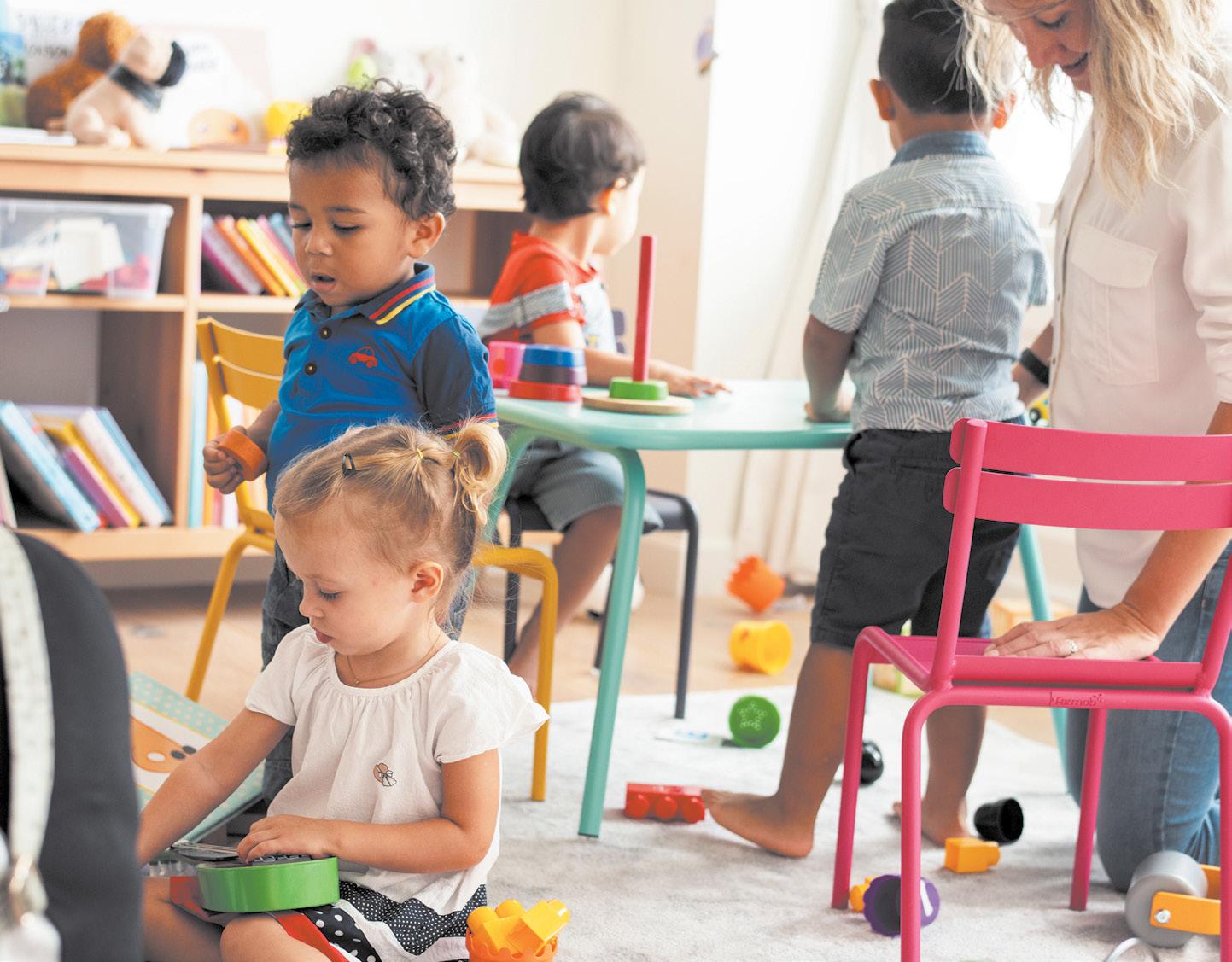
Budget-Friendly Childcare:
Money-Saving Tips for Parents
Istill remember the stress I felt when I had my first child. Some of it was about the typical things like how the pregnancy would go and what would labor be like. But the unexpected stress came when we considered childcare options.

As an elementary teacher and a nurse with student loan debt and a mortgage, we didn’t have a lot of extra money. Plus, we knew expenses would
increase when our little one arrived. So how were we going to make it work? We had to get creative. We decided to work different shifts so one of us could be with our daughter and we could save some money. Every day, I would leave work and meet my husband at the hospital to pick up our daughter as he arrived for his shift. This arrangement, while temporary, was simply our way of getting creative about our childcare options. As you consider the rising costs of childcare for your family and the need for safe, quality care, it may seem like there isn’t a way to make it less expensive. With a little creative thinking and flexibility, you can often
find a solution that works. Here are some money-saving tips to try.
Start with Your Jobs
Take time to brainstorm your work and ways you can make your job more flexible for your family. While not all jobs have these options, you’d be surprised at how many possibilities there are for work that aligns with your family’s needs. A few ideas include:
• Remote work
• Flexible hours
• Job sharing
• Freelance or Contract work
• Shift work
• Self-employment
Look at Different Types of Childcare
Not all childcare looks the same. Consider these ideas to maximize savings:
Cooperative Childcare: Coordinate with other parents in your community to share childcare responsibilities. You can take turns watching each other’s children or create a cooperative childcare arrangement where multiple families contribute to hiring a caregiver.
Family Support: If possible, rely on family members such as grandparents or aunts and uncles to help with childcare. They may be willing to assist for free or at a lower cost than professional childcare services.
Part-Time Care: Consider part-time childcare options instead of full-time if your schedule allows. This can significantly reduce costs while still providing care for your child during certain hours of the day.
In-Home Daycare Providers: In-home daycare providers may offer more affordable rates compared to larger childcare centers. Re-
12 WNY Family April 2024

search local providers carefully and ensure they meet safety and licensing standards.
Share a Nanny: If you have friends or neighbors with children of similar ages, consider sharing a nanny or caregiver. This allows you to split the cost of childcare while still providing personalized care for your child.
Community Resources: Explore community resources such as churches, community centers, or nonprofit organizations that may offer low-cost or subsidized childcare programs.
Seek Subsidized Care: Some childcare centers offer sliding scale fees based on income, while others may provide scholarships or subsidies for families in need. Inquire about these options with local childcare providers or social service agencies.
Seek Student Childcare Programs: Many universities and colleges with childcare or early childhood education programs offer discounted or subsidized childcare services provided by students under supervision.
Hire a Mother’s Helper: Instead of hiring a fulltime nanny or babysitter, consider hiring a mother’s helper—a responsible teenager or young adult who assists with childcare tasks at a lower rate.
Look for Additional Savings
There are a variety of savings opportunities available if you know where to look.
Tax Benefits: Take advantage of tax-advantaged childcare savings accounts such as Flexible Spending Accounts (FSAs) or Dependent Care Assistance Programs (DCAPs) offered by employers. These accounts allow you to set aside pretax dollars to cover childcare expenses.
Negotiate Fees: When discussing childcare arrangements with providers, don’t hesitate to negotiate fees or ask about discounts for paying in advance or referring other families.
Look for Discounts: Some childcare centers offer discounts for siblings or for enrolling children in multiple programs (e.g., preschool and after-school care). Ask about any available discounts when researching childcare options.
Bartering Services: Consider exchanging services with other parents or caregivers. For example, if you’re a skilled cook, you could provide meals in exchange for childcare services.
Community Resources: Take advantage of community resources such as libraries, community centers, or recreational facilities that offer free or low-cost childcare programs, storytimes, or playgroups.
Plan Carefully: Plan your childcare needs well in advance to avoid last-minute or emergency arrangements, which may be more costly. By having a clear schedule and understanding your needs, you can better negotiate rates and find more affordable options.
By thinking outside the box and exploring unconventional childcare options, you can find unique ways to save money while ensuring your children receive quality care and supervision.


April 2024 WNY Family 13
Pre-K 3-8th Grade Opportunities Family Atmosphere Small Class Sizes Excellent Teachers and Staff Extracurricular Activities Our Tradition: An Education for the Future, Values for Life 5480 Main Street Williamsville, NY 14221 716-632-6146 www.ssppschool.com WHAT WE OFFER: Registration Now Open for 2024-2025 Not Kindergarten-ready yet? Try our NEW Pre-K5 Class!



























14 WNY Family April 2024 Choosing Childcare Your Guide to A Special Section Dedicated To Helping Parents Find Quality Care To Fit Their Family’s Unique Needs Choosing Childcare appears in our JANUARY, FEBRUARY, APRIL, JULY, AUGUST & SEPTEMBER ISSUES Call today to reserve your space 716-836-3486 www.BigIdeasPreschool.com 500 CrossPoint Parkway, Getzville NY, 14068 Classes Offered for 3-5 Year Olds. For More Information: 716.250.5082 or jstaebell@thechapel.com School Day 9am - 12noon Register Now FALL 2024 Quality Preschool Education Enroll Your 3 or 4 Year Old Today! Six Centers Serving Buffalo & Tonawanda ✓ Buffalo Universal Pre-K On-site ✓ Before & After Care Services Available Call 852-8373 Visit us at www.holycrossheadstart.org
W2-Year-Old
Preschool Classes
hy is it important to have high quality child care? According to the American Academy of Pediatrics, all of a child’s early experiences, whether at home, in child care, or in other preschool settings are educational. The indicators of high quality child care have been studied and are available in many formats. When care is consistent, emotionally supportive, and appropriate to the child’s age, development, and temperament, there is a positive effect on children and families.

M/W or T/TH
3-Year-Old
Preschool Classes • T/TH or M/W/F
Depending on each child’s needs, benefits of high quality child care can include:
• Enhanced brain growth and child development
• Greater success in school (better math and language skills)
• Better cognition, social skills, interpersonal relationships, and self-regulation
• Decreased need for special education and related services later
• Lower adolescent pregnancy rates and lower juvenile crime
• Higher graduation rates
Locally, you can visit the Child Care Resource Network at https://wnychildren.org/ or call them at 716-877-6666 for resources. Visit childcareaware.org for additional information on making your childcare decision.




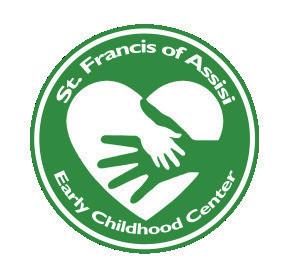






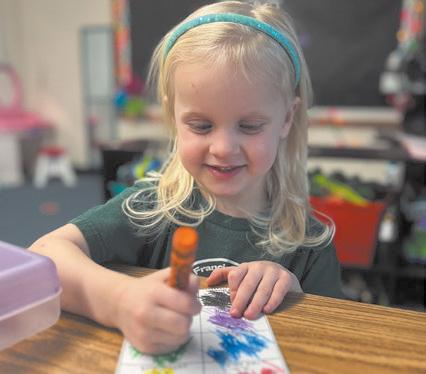






April 2024 WNY Family 15 CHOOSING CHILDCARE
Registration Now Underway for 2024 - 2025 2-Year-Old Preschool Classes T/TH 3-Year-Old Preschool Classes T/TH or M/W/F 4 & 5-Year-Old K-Ready M-F Parent’s Day Out 22 Months and Up www.page1preschool.com
•
•
Day
Guiding the hands and hearts of our future ENROLLMENT 2024-2025 70 Adam Street, Tonawanda, NY 14150 Call: 716-692-7886 or email Shengst93@gmail.com Schedule A Tour We proudly offer the following programs: • PreK-3: 3 day, 5 day. Half and full day • PreK-4 full day • UPK for City of Tonawanda residents with full day option Before and Aftercare PLAY LEARN ENJOY St. Francis Early Childhood Center Roots of the Future Montessori Pre-K and Kindergarten 8970 Main Street, Clarence, NY 716-545-8048 www.rootsofthefuture.com Enroll for 2025-26 Ages 2.9 - 6 Call for a tour!
4 & 5-Year-Old K-Ready
M-F Parent’s
Out 22 Months and Up
 – by Peggy Gisler and Marge Eberts
– by Peggy Gisler and Marge Eberts
Helping all parents make their children’s educational experience as successful as possible
Having Your Children Participate in Activities
Parents: Before you ever sign your young children up for any formal activity from a sport to music to dancing or singing, they should be doing some of these activities at home with you. Dance with your toddlers, sing with them, play catch with them, and let them frolic in kiddie pools. This will give you an early picture of what activities they particularly enjoy.
The Benefit of Activities for Children
One of the greatest benefits of participating in an activity, whether it is an individual or a team one, is that it is a way for children to have fun. If they are not having fun, or you have coerced them to take up an activity, it is not likely to be the right activity for them. A very obvious benefit of any activity is developing a new skill. This is coupled with other benefits like enhancing self-esteem and self-awareness, doing better socially, and gaining personal confidence. Plus, activities that involve other children teach teamwork and cooperation skills. In addition, participation in extracurricular activities often leads to success in the classroom.
Choosing the Right Activity
The younger children are, the choosing of activities for them largely belongs to parents. However, as children begin to enter school, many will have a good idea of what activities they would like to try.
No matter who chooses an activity, parents need to consider these factors: the level of involvement required, the cost, what their children’s friends are doing, and if participation in the activity will be burdensome for the family. Opportunities abound for children to participate in activities at Y’s, in park programs, some community organizations, as well as skill lesson programs. An easy way to find out what is available in your community is by looking at ads in this magazine and talking to other parents.
The Time to Start Participating in Activities
Today, there is a tendency for children to start participating in activities outside of their families when they are just toddlers. Physicians, mental health experts, and teachers of specific activities are definitely not in total agreement about what is the best age to start a specific activity. In general, everyone agrees that children develop at different rates, and that this should be considered before having them start a specific activity. If you push them into an activity too early, you may scare them away from it. Here’s a look at the ages considered appropriate for engaging in a few activities:
Swimming: One activity that all children should participate in is swimming lessons. While some parents start their infants in swimming classes, the American Academy of Pediatricians (AAP) advises that there is no current
evidence that infant swim programs for babies under 1 year old lower their drowning risk. However, they also state that for parents to be in a water class with their infant can get the child used to being in a pool and be a fun activity for them to share. The AAP advises that by their 4th birthday, most children are ready for swimming lessons and that by the age of 5 or 6 most can master the front crawl.
Sports: Children as young as age 4 or 5 can try a sport. And by the ages of 6 or 7, most will have the physical skills and attention span to learn how to play a sport. Experts, however, advise holding off their participation in competing until ages 7 or 8. The AAP says that before adolescence, young children should avoid specializing in a sport and should be encouraged to play a variety of sports. Warriors basketball star Stephen Curry would agree with this as he did not concentrate on basketball until he was a teenager.
Dancing: Little children as young as 2 who are already movers and shakers can be ready for a dance class. It is imperative that it be one that is designed for their age group. For children who want to take dance seriously, ages between 7 and 9 are the time to begin formal instruction.
Gymnastics: The best age for starting gymnastics is when children want to do it. Nevertheless, USA Gymnastics, the governing body for elite gymnasts, wants children to begin training between ages 2 and 5. This is one sport that can involve a lot of competition. However, it can also be a sport that is engaged in just for fun that can be started at any age.
Music: Toddlers can begin informal music lessons where they learn to identify the beat and melody in music as well as the sound of different instruments. By age 5, children can begin semi-formal music lessons. However, the preferred age for beginning music lessons is between ages 6 and 9.
Singing: The best age for children to begin singing lessons is when they continued on page 46
16 WNY Family April 2024 DEAR TEACHER
PICK OF THE LITERATURE
— by Dr. Donna Phillips

Have you heard it? The sounds of harbingers of Spring! It is not just the winter calls of the Blue Jays, or the Cardinals, or even the caws of crows. It is the chirps and inquiries of Robins and Redwinged Blackbirds. Those are the voices that we want to hear to know that Spring is really here! There are other sounds too. Soon we will hear the winds rustling the newly emerged leaves. Bees will start buzzing. We also have sounds that will disappear. The honks of Canada Geese will diminish, and the whistles and trumpets of the overwintering swans will no longer be heard. Spring is the time to celebrate birds and the beauty they add to the world around us.
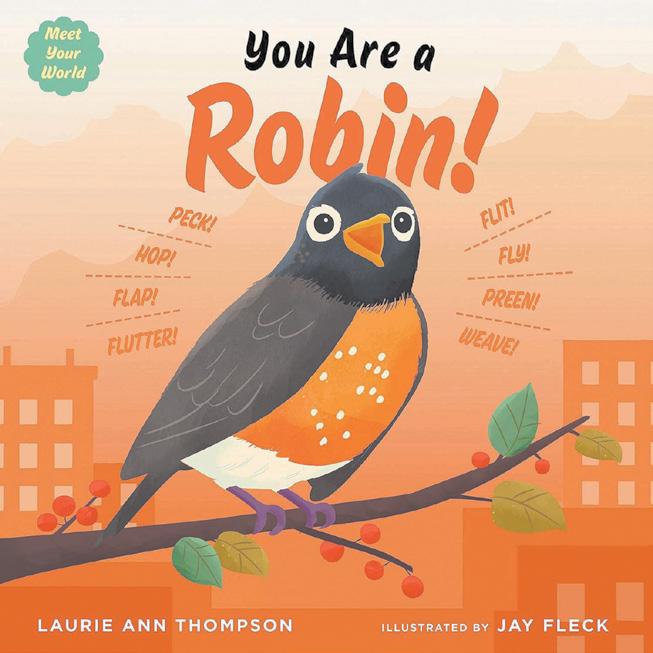
tions. It all begins with hatching out of an egg and takes us though learning to fly, exploring the world, and eventually building a nest and starting the cycle all over again! Somatic integration of learning is a powerful way to understand and retain information. This book is wonderful for watching birds as they build nests, rear their young, and take us through the cycles of life and the seasons.
Birds for Kids (Callisto Publishing, Naperville, 2024, $8.99) by Melissa Mayntz is part of their Junior Scientists Guide. This is the perfect book for older children who are interested in exploring the world of birds. Part One: Remarkable Birds addresses important and interesting information about their life, habits, and behaviors.

You are a Robin (Dial Books for Young Readers, New York, 2024, $18.99), written by Laurie Ann Thompson and illustrated by Jay Fleck, is a wonderful way to introduce young children to what it is like to be a bird by acting like one. Part of the Meet Your World collection, the simple text takes us through the life cycle of a robin as it develops and it encourages us to act it out with simple ac-
Part Two: Birds Up Close does a deeper dive into specific species. From our common American Robin, Northern Cardinal, Blue Jay, Killdeer, Red-Tailed Hawk, Turkey Vulture, and the Canada Goose to more exotic species that include the Atlantic Puffin, the Ostrich, the Emperor Penguin, the Indian Peafowl and the Belted Kingfisher, this book is fascinating and a great field guide. Photographs, illus-
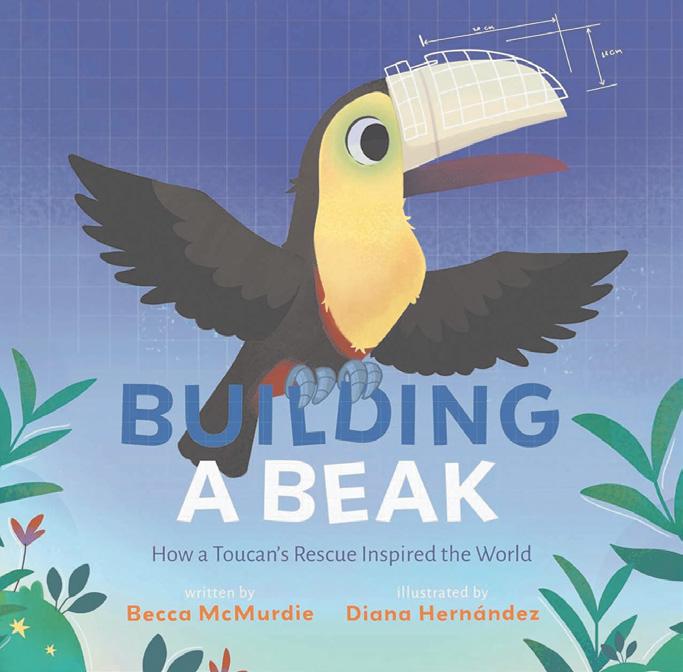
trations, charts, maps and more make this a book for all ages and will be perfect as we begin to go outside and begin to integrate ourselves into our surrounding.
What happens when a bird gets broken? It often takes a human to help out. In this case it was a group of humans from across the world. Building a Beak: How a Toucan’s Rescue Inspired the World (Page Street Kids, Salem, 2024, $18.99), written by Becca McMurdie and illustrated by Diana Hernandez, is the fascinating story of how veterinarians in Costa Rica helped a Toucan who broke her beak. Because of this she could not sing, eat, bathe, balance, or even move. This was not an easy task. It had never been done before. Dentists, engineers and bird experts all stepped up to help her out. With the help of a 3D printer, special glue, and an engineer with experience in building nosecones for airplanes, they were able to build her a new beak! This book explains the engineering behind this project in a simple way. With the support of the community, and those from around the world, this project brought everyone together to do what may have seemed impossible.
As we begin to spend more time outdoors, there is so much to do and explore beyond birds. Stay Curious and Keep Exploring Next Level (Chronicle Prism Books, San Francisco, 2024, $22.95) by Emily Calandrelli is just the book we need to open our senses and our minds to the possibilities that lay before us. This book has 50 science ex-
April 2024 WNY Family 17
46
continued on page
 — by Rebecca Hastings
— by Rebecca Hastings
Be Prepared for the End of the School Year Slide
It happens the same way every year. The school calendar days begin to countdown and I feel frazzled. You would think I would be ready for it, expecting the onslaught of papers coming home, projects due, last-minute field trips, and end-of-the-year concerts, parties, and assemblies. After 19 years of parenting, one would think I would be ready.
Instead, I find myself scrambling. By midMay I’m wound tight, running from place to place unsure we can fit it all in with a smile on my face (or, at least, remain standing). To be proactive I’m doing something about it. I don’t want the rest of the year to feel like a vortex sucking us all down. Not this year. No ma’am. This year I’ve got a game plan.

what you have now so you will be ready. And this does not mean just moving it to a new pile or basket. Be ruthless and get rid of anything you don’t need. File away the things you need. Do we even file anymore? Well, you get the idea. Purge the papers.
2. Create a space.
Make sure you have some glue sticks and markers that still work. Have a few sheets of poster board around or some colored paper. Those last-minute end-of-the-year projects will be a lot less stressful if you can avoid a 9 p.m. Walmart run. Just think of it as getting craft supplies for the “I’m bored” days of summer.
4. Clear the calendar.
Here are 10 things to do today to get ready for the end of the school year.
1. Get rid of as many papers as you can.
You know the deluge is coming. The art projects, the worksheets, the reports with stickers on the front. Clear out
In the last weeks of school, the kids will be coming home with full backpacks ready to empty on the kitchen table five minutes before dinner. Not this year. Get a basket with their name. Better yet, a box. You can even let them decorate it to get excited about everything they will bring home. Give the box a home and tell them all end-ofthe-year stuff goes right in their special box. Set aside a time you can go through it together, preferably not while stirring spaghetti sauce and setting the table. This way you can give all the appropriate ooohs and aaahs
3. Gear up.
Now, hear me out on this. I know the end of the year feels like the last time you would want to stock up on school supplies. But trust me on this.
Here’s your chance to get ready. This is not the time of the year to add in extra, unnecessary events. That calendar is going to fill up fast and without warning. It’s not the best time to have a stressful dinner party or make extra appointments. Clear what you can to make room for what’s coming.
5. Track it.
Now that the calendar is cleared, track the incoming dates like it’s your job. Find out when the band concert or

18 WNY Family April 2024
continued on page 39

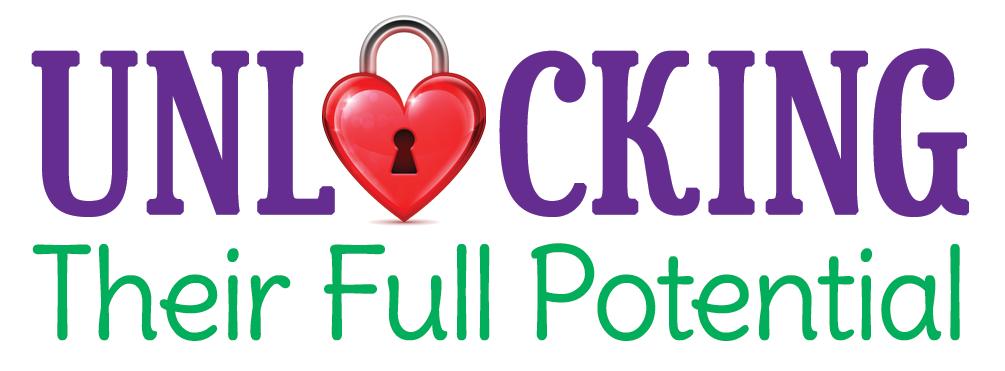
SPECIAL NEEDS WNY Family Magazine | April 2024 | PULL-OUT & SAVE

While some disabilities demand recognition via a wheelchair, hearing aid, or portable oxygen tank, others are more subtle. But that doesn’t make them any less real. Known as invisible disabilities, they affect 96% of people who have a chronic medical condition, according to one estimate. Caring for a child with any kind of disability presents extra challenges. For the parents of kids with invisible disabilities, those challenges often include the perceptions of their communities — including friends, family, neighbors, and teachers — perceptions that are uninformed at best and hostile at worst.
I talked to parents of kids with invisible disabilities including Autism Spectrum Disorder (ASD), Avoidant and Resistive Food Intake Disorder (ARFID), hemophilia, and many others to find out what they wish more people understood about their experiences.
SENSORY PROCESSING ISSUES ARE NOT DISCIPLINE ISSUES
According to the American Occupational Therapy Association, sensory processing affects virtually all aspects of a child’s daily life, including motor coordination, school performance, and relationships. A child with sensory processing disorder could have 20/20 vi-
sion and perfect hearing, but when he is in a crowded mall, his brain is not able to manage all of the auditory and visual information he’s receiving through his eyes and ears. While each kid reacts differently to overstimulation, some will scream or become physically aggressive.
What may look like defiance is just a kid doing his best to manage a stressful environment. The assumption that a lack of discipline indicates a failure by the parent is totally without merit. Jaime has a five-year-old son with level one high functioning ASD. She says, “discipline will not prevent him from being overwhelmed by his environment.” Says Lainie Gutterman, the mom of a sevenyear-old boy with ASD, when he is having a meltdown, “Staring, pointing and offering your two cents is NOT helping the situation and will most likely cause my son or myself to feel worse and [his] behaviors to escalate.”
Similarly, Jennifer Lynn, whose son has ADHD, wishes people understood she’s not being rude or indulging her children when she leaves a party abruptly. “It’s just that we see the warning signs and are trying to help our kiddo avoid a meltdown.” She says events like family gatherings or vacations, which are fun for most people, “are stressful for our family because it’s just too much everything.”
4 Things Moms
of Kids with Invisible Disabilities Want You to Know
— by Pam Moore
A LITTLE COMPASSION GOES A LONG WAY
Regardless of their child’s diagnosis, virtually every parent I talked to described the pain of receiving judgment instead of compassion. Sarah Cottrell, whose son has hemophilia, is tired of challenging people’s assumptions about his diagnosis. She says, “He doesn’t have AIDS and hemophilia isn’t caused by incest. Enough with the wild theories because we need compassion and empathy for the unseen pain issues and unending fear and anxiety over covering his insurance.”
Most parents I talked to, particularly those of kids with sensory processing disorders, described organizing their days around their kids’ strict routines. Every parent understands how easily the best-laid plans for meals, naps, and bedtimes can implode. What many parents don’t understand is how much higher the stakes are when your special-needs child depends on predictability for a sense of safety. Says Lisa Rosen, who says she must wake up 90 minutes before her kids in order to prepare for the non-stop mental and physical energy her son requires, “When adults look at my child, they see a happy kid... But I know that if ONE thing is off in our routine, I’m dealing with Hiroshima.” Her son Ezra, age three, has sensory processing disorder and is speech delayed. According to
20 WNY Family April 2024
Rosen, something as seemingly minor as the smell of a classmate’s detergent could cause him to meltdown to the point where she must carry him out of the classroom. She described her family’s disappointing lack of understanding when she could not attend the funeral of a family member, due to a lack of childcare coupled with Ezra’s regimented schedule and complex needs. “Who knew compassion was so difficult to come by?” she asks.
The predictability some kids require doesn’t just extend to schedules and environments, but also to food. Brianna Bell and Jennifer Gregory each have a child with sensory processing disorder that makes them intolerant of many foods. Because of this, Bell hates sharing meals with friends. She says, “There is so much pressure from others for her to eat this and that and not be so picky. I feel rude bringing my own food but she starves if I don’t. And people just don’t understand and assume she’s spoiled.” Gregory asserts that her family doesn’t often eat together, often serves alternative meals, and that they allow screens at the table, and that works for them. She wants people to understand that for her family, “Mealtime is chock full of stress and anxiety and the goal is to get food into our son’s belly because he doesn’t eat enough. If an iPad distracts him from smells and texture and allows him to eat more, so be it.”
Parents described not only a shortage of kindness from other parents, but also from other children. Lisa Beach recalled her son’s adolescent years as being particularly isolating. He is now 20 and has Asperger’s. Beach’s advice to parents is simple: “Teach [your] kids to reach out and include rather than label and judge.”
JUST BECAUSE YOU
CAN’T
SEE IT DOESN’T MEAN IT’S NOT THERE
When a parent is struggling to find a diagnosis, pay for therapies, or just get through the day with a kid who has an invisible disability, it is not helpful to
insist nothing’s wrong because their kid looks so “normal” or that her IQ is so high. What may be intended as a compliment may come as a slap in the face to the parent who has committed precious time, energy, and money to her child’s disability.
Samantha Taylor’s 13-year-old has high functioning autism, generalized anxiety disorder and an eating disorder, while her ten-year-old has dysgraphia and anxiety. Although Taylor is open with her friends and family about her kids’ diagnoses, because they appear “normal,” she says people are often shocked when her kids say something inappropriate or react in a way that is out of proportion to the situation. Says Taylor, “While it might look to everyone in our lives that we are holding it all together, I worry about my boys every single day. I wake up thinking about what I can do to make their day easier, and go to bed wondering if I did enough.” In search of a supportive community, Taylor ended up creating a thriving Facebook group for moms of kids with special needs.
One mother who prefers anonymity describes feeling frustrated when people judge her for coming to her son’s aid. He is in his early 20’s and has high functioning Asperger Syndrome. While she may appear overprotective, that is not the case. She says, “High functioning individuals are acutely aware that they are different and sometimes have self-confidence issues. Shaming them for needing help is not productive and can contribute to anxiety and depression. Thoughtless comments can sometimes ‘undo’ progress that has been made.”
YOU’RE AN ADVOCATE
Parents of kids with invisible disabilities are not just responsible for feeding, clothing, loving, disciplining, and teaching their kids. They must also advocate for their kids in a system that does not always have their best interests at heart.
One mom, who preferred to remain anonymous, described the challenge of continued on page 32

April 2024 WNY Family 21
is Critical for Strong Relationships, But ADHD Can Get in the Way
— by Cheryl Maguire
Agroup of medical school friends nominated Sasha Hamdani to create a memory book for their pregnant classmate. Hamdani worked hard on the task for several weeks. She printed pictures, gathered mementos and listened to stories about their friend. The book — meant to be a group gift for their classmate’s baby shower — was more than 100 pages long, with items such as anatomy class doodles and fabric from a white medical coat.
On the flight to the baby shower from Kansas, Hamdani realized when she was searching in her bag for her headphones that she had left the memory book behind. She felt awful. “I’m sure that half of the people here thought I never even made anything,” she recalled thinking.
Hamdani, now 35, was diagnosed with attention-deficit/hyperactivity disorder at age 9. She frequently misplaces important items, runs late or struggles with a disorganized purse — all symptoms of ADHD. She has been labeled a “flake” because she forgets social engagements or to reply to texts. People have often told her, “If it was important
to you, you’d remember.”
The repercussions of such missteps are an important yet underdiscussed issue for children and adults diagnosed with ADHD. While most people think of this disorder as causing difficulties with completing assignments in school or the workplace, it can also lead to a deficit in what experts call “social capital.”
“Social capital is the network and goodwill that you have with other people that help you not only accomplish tasks, but also [maintain] important social connections,” said Caroline Maguire, a family coach in Massachusetts and the author of Why Will No One Play with Me? Once you amass social capital, you can then draw on it by asking for help when needed.
Here are some reasons people with ADHD might not have much social capital to draw on, how a lack of such capital can affect them, and what can be done to build social capital.
WHY CHILDREN AND ADULTS WITH ADHD SOMETIMES LACK SOCIAL CAPITAL
Poorly managed ADHD. Failure to treat symptoms — such as not paying attention or being disorganized — with
medication or counseling, can lead to relationship problems. For example, a person with ADHD may forget to put away their clothes or leave dirty dishes on the table, annoying their partner. Over time, this can leave their partner feeling unsupported and resentful.
Even those who are being treated might skip their medication during the weekend, believing it’s unnecessary if they’re not at work or school. But weekends are when people socialize with friends or family. Ari Tuckman, a psychologist in Pennsylvania and the author of ADHD After Dark: Better Sex Life, Better Relationship, said that when people with ADHD don’t take their medication on weekends, they may experience problems in their relationships. One of Tuckman’s clients told her husband, who has ADHD, “Your co-workers get ‘Medicated Joe,’ and I get ‘Unmedicated Joe.’”
Trouble with social cues. Even with the proper medication, people who have ADHD may still struggle with paying attention to social cues. “If you don’t read social cues, which a lot of ADHD kids don’t, then they might not even realize the social ramifications” of their actions, Maguire said.
In social situations, people with
22 WNY Family April 2024 Building
Capital
Social
ADHD may impulsively interrupt conversations or have trouble waiting their turn during a game. For example, if a group of children at a birthday party are all waiting patiently to hit a piñata, the child with ADHD might run up, jump to the head of the line and hit it. This might cause the other children to feel angry.
Ryan Wexelblatt, a clinical social worker in New Jersey who specializes in ADHD, said that people with the disorder have trouble understanding other people’s thoughts and feelings. The partner of a person who has ADHD might consider their relationship one-sided and think, “They’re asking me for something but not really giving anything in return,” he said. This inability to invest in social relationships also leads to a lack of social capital.
Lack of face-to-face peer interactions. Children who have ADHD might avoid in-person interactions because their difficulties with social cues lead to shallow connections. They’re often drawn to video games because of the stimulation they receive from them, Wexelblatt said. But when kids play video games or engage in other solitary activities, they aren’t spending time with peers or building relationships; instead, they’re retreating into an artificial world with superficial relationships.
Difficulty with executive-functioning skills. Organization, planning, and memory are helpful not only in school or the workplace, but also in relationships. If a person with ADHD is always late to meet a friend for lunch, then that friend could eventually feel they can’t rely on that person or they don’t value their time.
“One social expectation is that you be on time. If you text me, you respond to my text,” said Maguire. If people with ADHD don’t adhere to these social norms, relationships can suffer.
People with ADHD sometimes struggle with what experts call “time blindness” — when you are unaware of the passage of time. This behavior can also disrupt relationships.
“If they’re chronically late and they don’t have a real excuse and say, ‘Oh, I was on TikTok, and I just spaced,’” their friends will feel upset, said Anita Robertson, a clinical social worker in Texas and the author of, ADHD & Us: A Couple’s Guide to Loving and Living with Adult ADHD.
Other people’s misunderstanding of ADHD. “ADHD is not taken seriously, and it’s looked at as a character flaw,” Wexelblatt said. That can mean that people with ADHD aren’t given the benefit of the doubt in social situations or assumed to be “flakes,” as Hamdani has been labeled. For example, if a person tells their friend with ADHD about an upcoming job interview that they are nervous about, but that friend later forgets to ask how it went, it could be misinterpreted as not caring.
HOW A LACK OF SOCIAL CAPITAL AFFECTS CHILDREN AND ADULTS WITH ADHD
A lack of social capital may translate to a lack of friends. A 2021 study done at the Peres Academic Center in Israel found that parents of children with ADHD perceived their kids as lonelier than those without the diagnosis. “These kids [with ADHD] may not get the same number of invitations to hang out,” Tuckman said.
A 2019 study conducted at the University at Buffalo showed that adults with ADHD experienced more interpersonal problems compared to those without the diagnosis. They may try to make up for their lack of social capital by being people-pleasers.
“They tend to get involved in romantic relationships with people who take advantage of them,” Wexelblatt said. Alternatively, they may overpromise to make up for past mistakes. But that sets people up for failure, said J. Russell Ramsay, a clinical psychologist and the author of five books related to adult ADHD. “They think that there’s no way I can keep up with this.”
Whether a child or adult, Maguire said, “if you don’t feel like your social connections are successful, then you start to lack confidence, and it spirals.”
HOW TO BUILD SOCIAL CAPITAL
Manage ADHD symptoms. One way to build social capital is by managing ADHD symptoms through medication and counseling. When symptoms like inattention, disorganization, and impulsivity are managed, then the person with ADHD will be able to interact with others in socially acceptable ways.
Another way to help people with ADHD be successful in relationships is to create routines and structure. If the expectation is specific, like taking out the garbage every Wednesday night at 6, then it becomes a habit that is easier to remember.
Set up positive social environments. Ramsay said that often children don’t have a social-skills deficit; rather, they have trouble understanding when to appropriately use the skills. People with ADHD can improve their social skills through an exercise Maguire created called “Social Spy.” Go to a location where people like to gather and watch them (discreetly), paying attention to social norms like turn-taking. Then challenge yourself to detect social cues.
Robertson suggested turning tasks into games for both kids and adults, to make them more interesting and enjoyable. “ADHD brains are at their best when they’re having fun,” the clinical social worker wrote in her book. For example, you could say, “I’m going to time you and see how fast you can put the laundry away.” You could ask them to guess how fast they can do the task or see if they could beat their record from the last time.
Educating others about ADHD. Parents may need to educate teachers or their child’s friends about ways their child with ADHD might struggle with continued on page 35
April 2024 WNY Family 23
Breaking the Code
— by Vickie Rubin
Our daughter Jessica, age 41, was born with a rare chromosome deletion, 1Q4344. She needs assistance with all daily life skills and is non-verbal.
When Jessica was in middle school, she always appeared alert and aware of her surroundings. However, there was no back-and-forth verbal communication. I couldn’t ask Jess to make a choice. Phrases we take for granted, such as saying “yes” or “no,” “I’m happy,” “I’m hurt’, and “I’m hungry” were trapped inside of Jess. We were desperate to find a way to release her thoughts.
Jess worked on sign language at school. We also tried picture boards plus other alternative communication strategies that were not successful.
The doctors annoyingly reminded us that Jessica’s IQ was so low that she was not motivated to communicate. The physicians insisted that she didn’t understand the relationship between communicative cause and effect. A request provides a response that fulfills a need. We disagreed because a light shone when we looked into Jessica’s eyes. My husband and I needed to know how to retrieve what was in her mind. How do we break her code?
One afternoon in 1994, my neighbor, Bea, told me about an 18-year-old boy using a new form of communication called Facilitated Communication (FC). This method was helping individuals with Autism, who were non-verbal, to interact with meaningful conversation. She encouraged me to call to get more information.
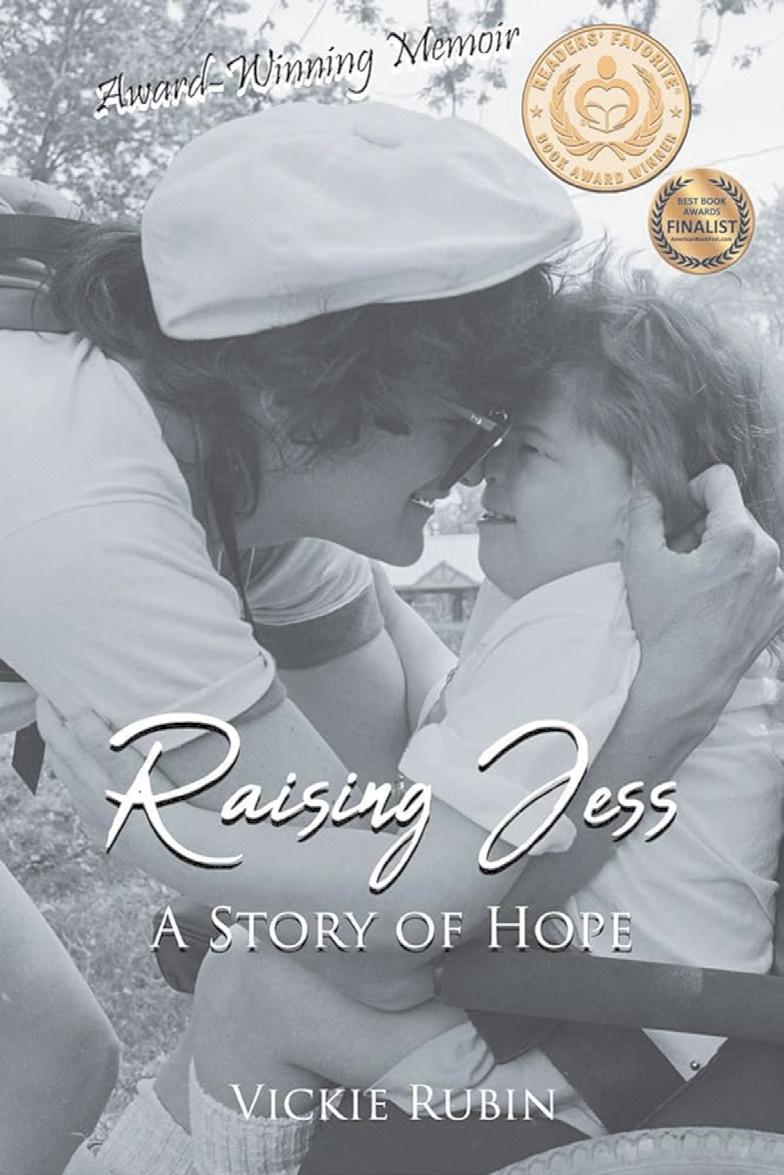
It took me two months to initiate that call. Was it fair to raise our hopes only to be disappointed? Eventually, we decided to call because if there was a possibility of giving Jess the ability to make a choice, we had to at least give it a chance.
I contacted the mother of the 18-year-old boy, who told me about Facilitated Communication. She explained its simplicity: the facilitator physically supports another person and helps that individual point to pictures or words. I started supporting Jess by isolating her index finger, which she still does independently to this day. Next, I supported her forearm, and when I felt Jessica’s hand move towards a letter, I offered slight resistance. The resistance helped stabilize Jessica’s hand so that she could select a letter accurately. It felt like an old-school Ouija board. The facilitator does not help select the letters; they only provide gentle support so the individual can freely choose the letters or words.
Fortunately, a two-day seminar at The University at Buffalo was offered the following week. The mother I had spoken to and her son were among the presenters. Her son generously let everyone facilitate with him. He wanted us to feel the power of Facilitated Communication so that we would be able to open the communication doors for others. Once you tried it, it was hard not to believe this strategy was authentic.
When
Jess came home from school that afternoon, I was ready and waiting with two index cards; “YES” was written on one card and “NO” on the other. I isolated Jessica’s index finger, slightly restrained her hand, and asked Jess if she wanted Chocolate milk (her favorite). My hand was pushed towards the “Yes” card. I asked Jess if she wanted water (least favorite), and Jess indicated “no.” I felt elation, disbelief, belief, skepticism; could this be a miracle?
Did Jess know how to read but had yet to show us before FC? Ok, it’s farfetched, but was it also possible? My mind was a whirl of questions. Did I want this so much that I was unintentionally guiding her hand toward what I thought to be Jessica’s answer? Facilitator guidance, deliberate or not, was a persistent criticism of FC that plagued me and other family members.
We worked on FC for over one year. Jess started spelling family members’ names; she knew the dates and could identify numbers. During an evaluation, she moved her fingers toward “Hi.” Imagine, after twelve years, a simple greeting; life changed forever.
From this point, we included Jessica in 5th-grade Math. Yes, we found out that Jessica could multiply, add and subtract. Jess was also able to identify money, and she began to learn more about
24 WNY Family April 2024
the world around her. We were amazed at all the information Jessica had absorbed incidentally. Without direct instruction, we suddenly realized that Jessica’s possibilities were limitless.
My husband, Mitch, and I never imagined Jess having this level of cognition. One day, I sat down with Jess and asked if there was anything she wanted to tell me. “I LOVE YOU, MOM,” was her message. I had been waiting twelve years to hear that.
So, as Paul Harvey, a beloved radio personality from the 70s to 2009, would say, “And now the rest of the story.”
My parents were visiting one weekend, and my dad and I decided to test FC. I still had a bit of skepticism. We played the FC game on the telephone, where my father whispered something into Jessica’s ear, and I would ask her to relay the message to me. It never worked, and we tried a lot. I came up with excuses such as Jessica didn’t get the game. Perhaps she didn’t want to play or was pulling one over on us. Alas, this became the beginning of the end for FC for us as other incongruities started to show up.
I requested that the school ask Jessica what she did over the weekend without giving the school relevant information. The answer was rarely correct. Some of her clinicians still believed that FC was a viable tool for Jess, and for many folks, it truly works. However, we ultimately stopped using this method as her only mode of communication.
I learned a few things in this process – Jess communicates
but not with words. She let me know that chocolate milk is her favorite, with beautiful smiles and voracious drinking. Jess lets us know when she is happy – just look at her face! Most importantly, she always tells us how much she loves us with hugs, glee when we walk in the room, kisses, screeches, and facial expressions. Jessica has her own language; if you take the time, you can break the code.
(Epilogue – it’s 2024, and Jess can hum 25 tunes and is constantly learning new songs. She still isolates her finger and uses this method to play the piano with her music therapist. Jess has developed the ability to use her iPad to make choices when helped. Never give up on finding new ways to broaden your family member’s world.)
This is a chapter from the book Raising Jess: A Story of Hope by Vickie Rubin. Reprinted with permission by the author.
Vickie Schlanger Rubin, M.S Ed. is a three-time awardwinning author of the inspiring memoir “Raising Jess: A Story of Hope”. She is an experienced public speaker and passionate advocate for families of children with disabilities. Vickie’s essays are published in Newsweek (My Turn), Buffalo News Opinion (My View), and guest blogs worldwide.
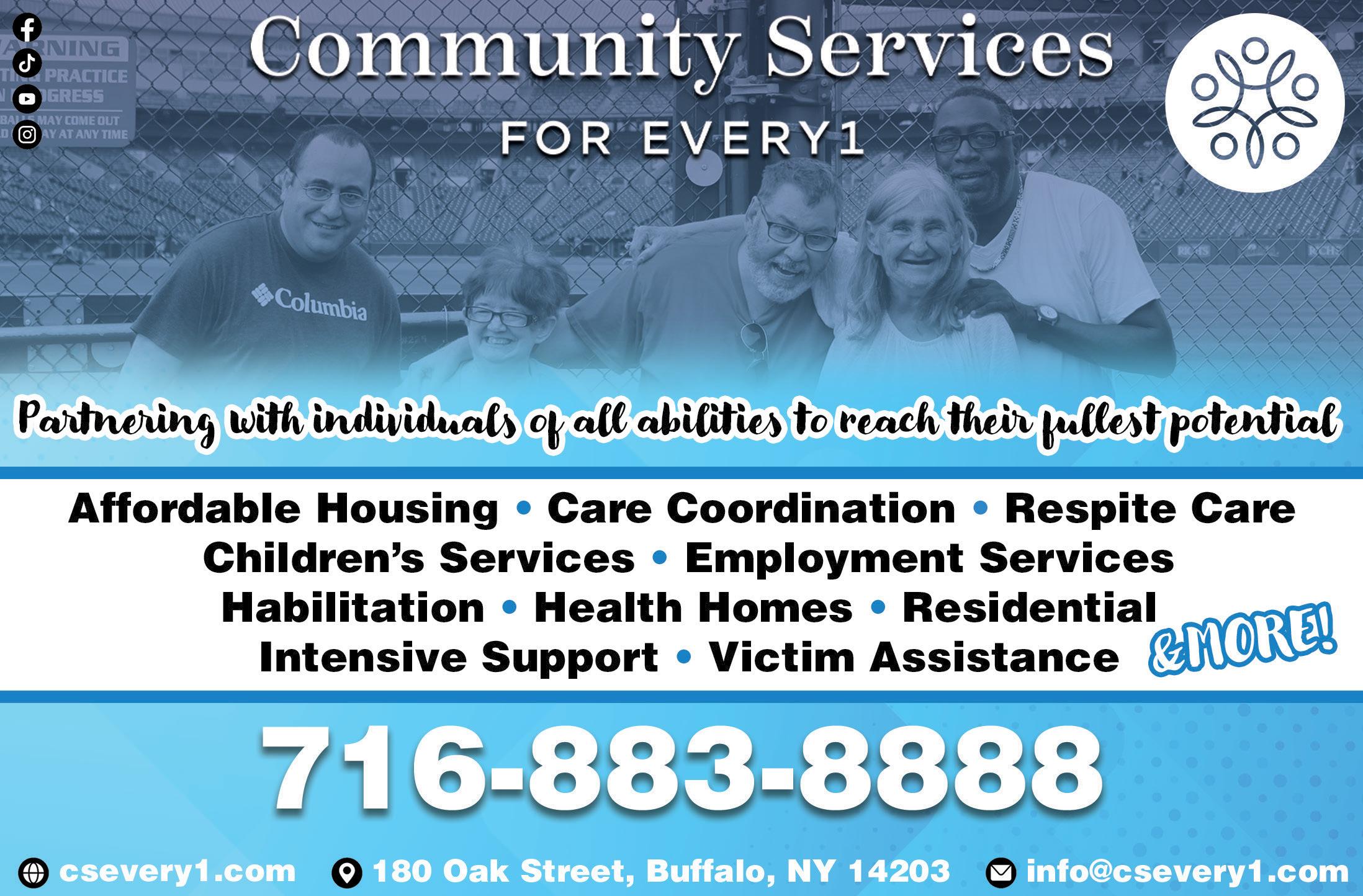
April 2024 WNY Family 25
What Parents Need to Know about Special Education Rights
— by Marion M. Walsh, Esq.

Many parents, at some point, may wonder if their child has a learning or emotional disability or special needs. Some parents know about the child’s challenges at birth or in early childhood. Others may not suspect a disability until a child is an adolescent or even a young adult, as some complex and invisible challenges, such as emotional disabilities, become pronounced in adolescence. Special education law covers a broad continuum of students. The Individuals with Disabilities Education Act (IDEA) requires that every public school district in the U.S. identify and evaluate students suspected of having a disability and provide a free, appropriate public education (FAPE) to every eligible student until graduation or the year after the individual turns 21.
STEPS TO TAKE IF YOU SUSPECT YOUR CHILD HAS A DISABILITY
If you suspect that your child has a disability affecting their education, you can refer them to your school district for special education services. Even if a parent does not refer a child, a school district has the affirmative obligation to conduct evaluations of students suspected of needing special education or related services. This “child find” obligation extends to children who may be advancing from grade to grade.
It is important for parents to know that school districts and parents often view children’s progress through a very different lens. Districts, in general, may tend to underestimate student needs, as districts face counter-pressure to not overclassify students.
A strong psycho-educational evaluation for a student is critical. Instead of relying on school district evaluations, parents may obtain private evaluations and present them to the school district. If you disagree with a school district evaluation and provide appropriate notice and a request, a public school district must, subject to certain limitations, provide an independent educational evaluation at public expense.
WHAT DISABILITIES ARE COVERED?
Under the IDEA, disability categories include: autism, deaf-blindness, deafness, an emotional disturbance, a hearing impairment, an intellectual disability (formerly known as “MR”), multiple disabilities, other health impairment (which can include ADHD), an orthopedic impairment, speech/language impairment, a specific leaning disability, traumatic brain injury, or a visual impairment. Remember, a diagnosis alone is not enough. The school district must find that the disability has an education impact and that the student needs special education and related services.
WHAT IS AN IEP?
Once a child is evaluated, a team of special education professionals must meet to decide if the child meets the criteria to receive special education services. This team then must develop an Individualized Education Program (IEP). An IEP represents the “centerpiece of the IDEA” and is a written statement outlining a plan for providing the free appropriate public education to which the child is entitled.
The IEP must include the student’s present levels of academic achievement and functional performance, and detail academic, physical, management, and social emotional needs. It must contain an annual goal for every special education need identified. Of course, the IEP must include the special education program and services, as well as any accommodations, including those for testing. The continuum of services can range from general education (with related services) up to a restrictive residential placement.
WHAT CONSTITUTES A FREE APPROPRIATE PUBLIC EDUCATION?
To provide a FAPE, a district must provide the special education and related services outlined in the IEP. The district must adhere to all substantive and procedural requirements of the IDEA.
How do you measure a FAPE? The U.S. Supreme Court held in 2017, in a case known as “Endrew F.,” that the IDEA “requires an educational program reasonably calculated to enable a child to make progress appropriate in light of the child’s circumstances.” The Court rejected the position that anything more than “de minimis,” or minimal, progress is acceptable. Rather, a child’s “educational program must be appropriately ambitious in light of his circumstances.”
Advancement from grade to grade is appropriately ambitious for most children in the regular classroom. The Court emphasized that the goals may differ, but every child should have the chance to meet challenging objectives. Many parent advocates are using this important precedent to advocate for higher standards in special education.
26 WNY Family April 2024
WHAT ARE TRANSITION SERVICES?
An IEP must also contain transition services and goals, which are absolutely essential for helping children with disabilities attain independent living. The IDEA requires that IEPs begin addressing transition no later than age 16. Some states and IEP teams begin earlier. The IEP must contain transitional goals and services which will facilitate movement from school to post-secondary activities.
WHAT ARE SOME PARENTAL REMEDIES?
The law gives parents specific rights under the IDEA concerning participation in the special education process and on notification and consent. Parents have the right to seek and review all of their child’s educational records, and school districts have the obligation to keep such records confidential.
If parents disagree with a school district IEP decision, they have the right to file for due process. This means that a school district must conduct a hearing before an impartial hearing officer, appointed through the state. While the hearing may take a single day, some last for many months. Either side can appeal to state or federal court.
Parents have the right to seek various remedies in an impartial hearing, including compensatory or made-up services. They cannot seek money damages but may be able to recover reimbursement for certain evaluations or services that a school district should have covered. Under the IDEA, parents have the right to unilaterally place their child in a private school and seek tuition reimbursement. Parents have the burden to show the private school is appropriate under the IDEA and must show that they cooperated with the district.
WHAT HAPPENS WHEN A CHILD GRADUATES OR TURNS 21?
After your child graduates with a regular education diploma or turns 21 or 22, depending on the state, the protec-
tions of the IDEA end. Section 504 of the Rehabilitation Act of 1973 and the Americans with Disabilities Education Act, do still protect the young adult from discrimination. These laws apply to colleges that receive federal funds, most employers and places of public accommodation. Your state will administer additional programs for young people with developmental disabilities. However, the laws do not require a FAPE or services to the extent of the IDEA. This is why special education advocacy up to age 21 is so important.
If you have questions about whether your child is being appropriately served or needs an IEP, it is a good idea to consult with a special education attorney in your state. The Council for Parent Advocates and Attorneys (COPAA) can provide a list of experienced professionals.
Marion M. Walsh, Esq.,is a partner with Littman Krooks LLP, which has offices in White Plains and New York City. She has worked in education law for over 20 years and leads the special education department at Littman Krooks. She is certified by the New York State Education Department as an impartial hearing officer for children with disabilities.
About this Article:
We hope you find this article useful and informative, but it is not the same as legal counsel. A free article is ultimately worth everything it costs you; you rely on it at your own risk. Good legal advice includes a review of all of the facts of your situation, including many that may at first blush seem to you not to matter. The plan it generates is sensitive to your goals and wishes while taking into account a whole panoply of laws, rules and practices, many not published. That is what SNA is all about. Contact information for a member in your state may be obtained by visiting www.specialneedsalliance.org/find-an-attorney/.
Reprinted with permission of the Special Needs Alliance – specialneedsalliance.org









April 2024 WNY Family 27
Center & Community Based Educational, Therapeutic & Evaluation Services for Developmentally Disabled Young Children Integrated Pre-School Classes in Collaboration with Head Start Specialized Services for Autism Spectrum Disorders 393 North Street Springville, NY 14141 716-592-9331 Visit us online at http://tclny.org Serving Erie, Cattaraugus, Chautauqua & Wyoming Counties
 — by Sarah Lyons
— by Sarah Lyons
How to Prepare for Your Child’s IEP Meeting
An individualized education plan (IEP) is a key component of your child’s special education plan. By law, schools are required to provide services to kids who qualify. An IEP meeting is where goals will be set and which services will be provided are decided on by both educators and the child’s guardians. This can be very intimidating for parents. With preparation and prior research, parents will feel more informed and confident during the meeting. The time spent before will lead them to be better advocates for their child while developing a plan that will help the child have more success in school while keeping everyone happy. Below you will find 6 steps to help best prepare you for your child’s IEP meeting.
1. TALK TO THE TEACHER
It is important to talk to your child’s teacher to determine how things are going at school. The teacher can help identify your child’s strengths and challenges and may suggest what services would be helpful to them. If possible, observe your child in the classroom to get a feel for
how social interactions and classroom learning are going. Knowing this information, as well as their current math and reading levels, will help you assist in setting goals during the IEP meeting.
2. READ UP
The school should send home a notice of meeting that states who will attend the IEP meeting, the reason for meeting, and, if applicable, goals set in the previous IEP meetings. Carefully read the information sent home so you understand what to expect. You may also consider studying special education laws that pertain to your child’s needs so you know what services you can legally ask for. There are many websites and books available to help parents prepare for IEP meetings as well. The more knowledge you have, the more confident and comfortable you will feel during the meeting.
3. SET GOALS
Prior to the meeting, write down questions you would like to ask at the meeting. This is also a great time to consider what visions and goals you have for your child and make note of them.
Bring your notes with you to the meeting so you can refer to them throughout the process. Having a list of questions and an idea of goals you would like to see your child reach will help you make sure that you cover everything you had hoped even if the emotions of the meeting make it more difficult to remember your questions and concerns. Don’t be afraid to ask for additional services for your child. The school may not provide everything you had in mind, but it never hurts to ask.
4. GET ORGANIZED
Collect any paperwork you need or would like to bring to the meeting and gather it in one place so it is neat and organized for the meeting. Bring your notes from your observation, your list of questions and goals you would like to set, and any medical paperwork that pertains to the IEP meeting. If you have had any private evaluations done, bring copies of those as well.
5. BRING AN ADVOCATE
Because IEP meetings can be intimidating, it can be helpful to bring an
28 WNY Family April 2024
advocate to the meeting with you. This could be a lawyer or, simply, a spouse or co-parent. Having a person there both for support and to be another advocate for your child can be a good boost of confidence for the parent to help ensure you meet the goals you would like for your child. Be sure to let your school know, in advance, who will be attending the meeting with you.
6. BE CONFIDENT
You know your child best and are the best person to represent their needs, challenges, and successes. While it can be emotional and overwhelming to address issues your child is facing when it comes to learning, setting goals and ensuring the proper services are provided is the best thing you can do for your child’s success in school. Dress appropriately for the meeting, bring the documents and notes you prepared, and speak confidently and lovingly about your child. Your preparation and concerns will be apparent to everyone at the meeting and you will have the reassurance that you were prepared and did your best to help your child be successful in school.
Sarah Lyons is a mom of six kids including seven-year-old triplets. She enjoys reading, writing, and spending time outdoors with her family.
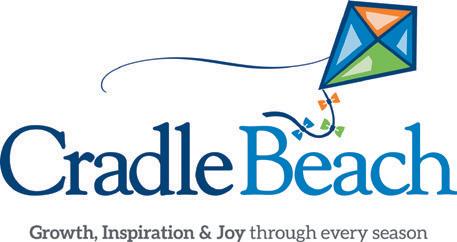

Cradle Beach offers an inclusive overnight summer camp for children ages 8-17.
We offer a nurturing, transformative, and fun experience in nature. Our camp sessions are designed to provide opportunities for skill building, to grow in confidence and to make new friends.
Camp Sessions begin on July 1st.
Eight sessions, 5 days each (Monday - Friday).

We offer financial aid to ensure all children can attend!
To register for Summer Camp, go to www.CradleBeach.org or call Admissions at (716) 549-6307 ext.205



8038 Old Lakeshore Road, Angola, NY 14006 (716) 549-6307 • www.CradleBeach.org














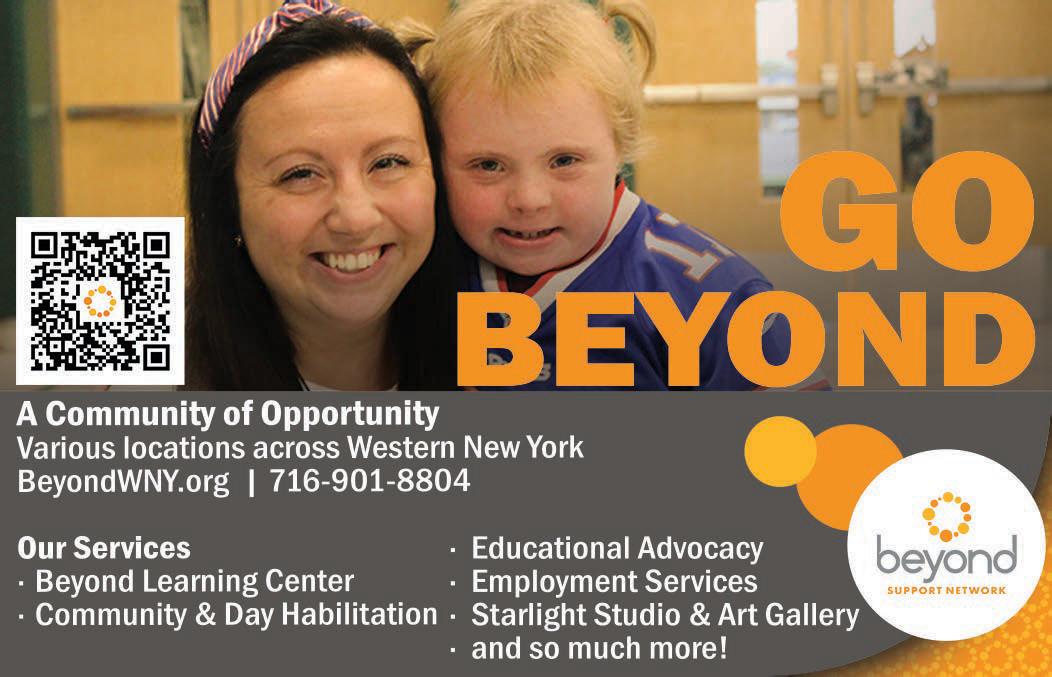

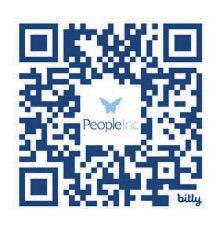
April 2024 WNY Family 29
 — by Carolyn Tomlin
— by Carolyn Tomlin
Intentional Grandparenting Special Needs Grandchildren
How Grandparents Make a Difference
“Todd” and “Emily” were so excited about the birth of their first grandchild. Both retired, they realized they would have extra time to spend being a part of this little one’s life. Of course, they would be present when the baby was born. After the birth, their son came into the hospital waiting room and said, “There is a problem. The doctor said our baby has Down Syndrome. He will be delayed in some areas…but there are still many things we can do together.”
“Seeing our son, trying to hold back the tears, was one of the saddest days of my life,” says Emily. “His face was ashen. He spoke as if his voice was outside his body.”
Data shows that in the U.S., 1 in every 33 babies are born with special needs, or 3 percent. For many couples, there is no known reason why this happens. No known family history of a disorder. No health issues during pregnancy. No preor post-delivery difficulty. No indication of a problem. It just happens. Three types of special needs are: physical, developmental, and behavioral/emotional.
“Our grandson is developing like
other babies, only he is a little behind what is expected at this stage. We are blessed to have this special little one in our lives,” says Emily. “This we know: this baby has brought our family closer together. We focus on what he can do— not what he is unable to do. This baby is a gift from God and is wonderfully made.”
Becoming an Intentional Grandparent
As grandparents of special needs grandchildren, realize you are needed. Make a commitment to become invested in the child’s spiritual development. Become an advocate for inclusion and equal rights. Speak up when others use the R-word. Regardless of a child born with a heart condition, medically fragile, or with an extra 21st chromosome—remember, they are children first. And they are created by God.
Whether you live nearby or a distance away, these suggestions will help support your adult children who are blessed with grandchildren who have special needs.
How Grandparents (Who Live Nearby) Can Help
Grandparents have many opportunities to help young families and be a vital part of making a difference with special needs grandchildren. If you live on the same street or community, count yourself blessed.
• Volunteer to babysit so parents can have time alone. What works best? Your home or their place?
• Cook and deliver a weekly meal. For example, choose one night a week. Or, order a meal and have it delivered.
• Become informed on the child’s disability. Research medical approved Internet sites. Most disabilities have a foundation that provides current and accurate information.
• Know and practice safety precautions when caring for the child.
• Be aware of allergies the child may have developed.
• Support specific groups focusing on the child’s disability, including continued on page 34
30 WNY Family April 2024
Neonatal Intensive Care Unit (NICU) Bags
When a baby is born with a disability, a stay in the NICU is the norm. Grandparents can help their adult children and also provide support for other families.
Purchase an inexpensive monogram canvas bag and fill with small gifts. Include items such as: gift cards for coffee, devotion book, small toilet items for parents, children’s book, a soft baby blanket and a snuggle toy.


Family Guide Resource A Resource Guide for Busy Families Put your business in front of WNY Family’s 55,000 readers by advertising in the Family Resource Guide. Coming up in our May issue: Choose from a basic line listing, display ad, or for more visibility choose a “Spotlight” advertorial. For More Information: Call Paul Kline at 716-836-3486
April 2024 WNY Family 31
4 THINGS MOMS OF KIDS WITH INVISIBLE DISABILITIES WANT YOU TO KNOW continued...
having a 12-year-old son who has ADHD and a learning disability. She described his teachers’ low expectations, recalling an Individualized Education Program (IEP) meeting where a teacher was clearly impressed with her son’s ‘C’, “and how great that was ‘for a kid on an IEP.’” To compensate for his teachers’ low expectations, she says she always reminds her son “[he] is smart and his IQ reflects that. There is no reason he shouldn’t be able to get an ‘A’… if he is provided with the right services.” She also described a general lack of understanding



of her son’s ADHD diagnosis among his teachers, which she feels causes them to set unreasonably high expectations of him in other areas, such as his ability to get organized or follow a schedule.
Delaina Baker, whose son is dyslexic and has auditory processing disorder, described similar struggles with her son’s school. She says she wishes teachers were more accommodating of his IEP. Says Baker, “It is my right to fight for my child and if you challenge my knowledge of his disability, I can assure you, I’ll have a spreadsheet, charts, and back-up data to prove it.” She says she is grateful to have found an ally in her son’s Exceptional Student Education (ESE) coordinator, whom she feels is her son’s only advocate beside herself.
Parenting is hard enough without adding other people’s assumptions to the equation. Parents of kids with invisible disabilities just want the world to know, it’s only okay to assume one thing: They and their kids are doing the best they can.
This article was originally published on Parent Co.
Pam Moore is an award-winning freelance writer, weightneutral health coach, and host of the Real Fit podcast. Get her free guide to improving your body image at pam-moore.com.










32 WNY Family April 2024 The benefits of riding are immeasurable. Everyone deserves the opportunity. www.sasinc.org/creative-opportunities/high-hurdles High Hurdles Therapeutic Riding A division of Do You Have Concerns About How Your Child is Developing and Learning? “Supporting families and professionals to empower individuals with disabilities to reach their full potential” We Can Help! We provide 1-On-1 Support and Education on Disabilities, Special Education and Services. All services are free of charge. www.parentnetworkwny.org • (716) 332-4170 • info@parentnetworkwny.org
INTENTIONAL GRANDPARENTING SPECIAL NEEDS GRANDCHILDREN continued...
• walk-a-thons, runs, golf teams, and other sports.
• As the child grows older, read stories to the child of people with similar disabilities and how they overcame this handicap and made a difference in the world.
• Provide one-on-one activities for other children in the family. Often a child with special needs receives so much attention and siblings feel left out.
How Grandparents
(Who Live Away) Can Help
Due to careers and job opportunities, young families may not live near grandparents or the extended family. Don’t allow distance to keep you from being involved with your special grandchildren.
• Use technology, such as FaceTime and Skype to stay connected.
• Send subscriptions of magazines or literature, including children and youth magazines to the family.
• Order weekly or monthly take-out meals from a restaurant where the family lives and have them delivered to their home. Check for a convenient time. Is there a weekly or monthly night when the wife or husband works late and must come home and prepare dinner?
• Send greeting cards, not only for birthdays, but other events throughout the year. Better yet, make your own personal cards.
• Communicate through digital photography and videos. Capture sensory experiences and make a video the grandchild can open on a Smartphone or computer. Young children learn best through their senses. Take this opportunity to explain about our 5 senses and teach that they are a gift from God. For example:
Sight - songbirds eating from a feeder
Sound - wind blowing, music, rain on the roof
Touch - show how to pet a puppy or kitten and feel its fur
Smell - fragrant flowers, cooking aromas
Taste - taking a bite of a banana or a spoon of peanut butter
Parents Advice for the Extended Family and Friends
One young mother posted on her Facebook page, “Don’t praise me for loving my child. Isn’t this what mothers and fathers are supposed to do?”
When a baby is born with special needs:
• Celebrate the birth as with any new addition to the family.
• Encourage grandparents to be involved with the baby. Relate specific ways they can be of help.
• Don’t put limitations on the child. See the potential—not the disability.
• Respect the family’s need for privacy. The parents need time to adjust and heal.
• Connect with church family and social media to find people who share similar situations.
• Become a messenger and support other parents. Make this your ministry.
• Educate others to be accepting of people with special needs.
• Become involved in a special needs group. For new parents, this can be frightening at first. There are many unknowns. Encourage grandparents to attend meetings with you.
• Find a church home where trained teachers and staff show that Jesus loves all children.
Carolyn Tomlin lives in Jackson, TN and writes for the magazine market. She has published over 6,000 articles and 17 books. Tomlin has a special needs grandson who has brought so much joy to her family.
Helpful Resources
Stay informed about children with special needs. Check reliable sources and learn how you can help.
• National KIDS COUNT Project - One of the best available resources on the economic, physical, educational and relational well-being of children and families in the United States, this organization focuses particularly on those who are vulnerable and at risk for poor outcomes.
• themighty.com – a weekly, free newsletter that encourages and enlightens families with special needs children.
• Suggested reading: Chosen for Charlie: When God Gifts You with a Special Needs Child by Jan Forsthoff. A transparent insight into the author’s journey of faith as she realizes God chose her to be the mother of a special needs child.
• Suggested reading: Hope Unfolding by Becky Thompson. Being a parent or grandparent is an awesome responsibility. God will give you the answers needed when you doubt your own ability.
34 WNY Family April 2024
relationships. Kids and adults with ADHD may also need to help other people understand their disorder.
“Often it’s psychoeducation for the non-ADHD partner about what ADHD is and is not, and what will be the frustrating points in relationships,” Ramsay said. He cautioned that people with ADHD are still responsible for their share of expectations, like household chores. But sometimes the non-ADHD person may incorrectly infer meaning to behaviors — for instance, if my partner forgets to mow the lawn, that means that they don’t care about the relationship.
Tuckman also discussed the importance of talking openly instead of making assumptions. “Try to create a relationship where both people can be honest and direct.”
Resources like Children and Adults with Attention-Deficit/Hyperactivity Disorder (chadd.org) and the website “ADDitude” (additudemag.com) can help people with ADHD and their families or friends.
Cheryl Maguire is a writer based in Massachusetts. Find her on X: @CherylMaguire05.







April 2024 WNY Family 35
BUILDING SOCIAL CAPITAL IS CRITICAL FOR STRONG RELATIONSHIPS,
IN
continued... Health & Wellness Matters to WNY Family Magazine Readers! Join us in educating local parents about how they can improve their family’s health. healthy healthy CHILD, FA M ILY healthy healthy CHILD, FA M ILY A Special Pull-Out Section Appearing July 2024 In Print & Online Family Space Reservation Deadline: Monday, June 10, 2024 Call Paul Kline at (716) 836-3486 for more information 24TH ANNUAL! 24TH ANNUAL!
BUT ADHD CAN GET
THE WAY
— by Sarah Lyons
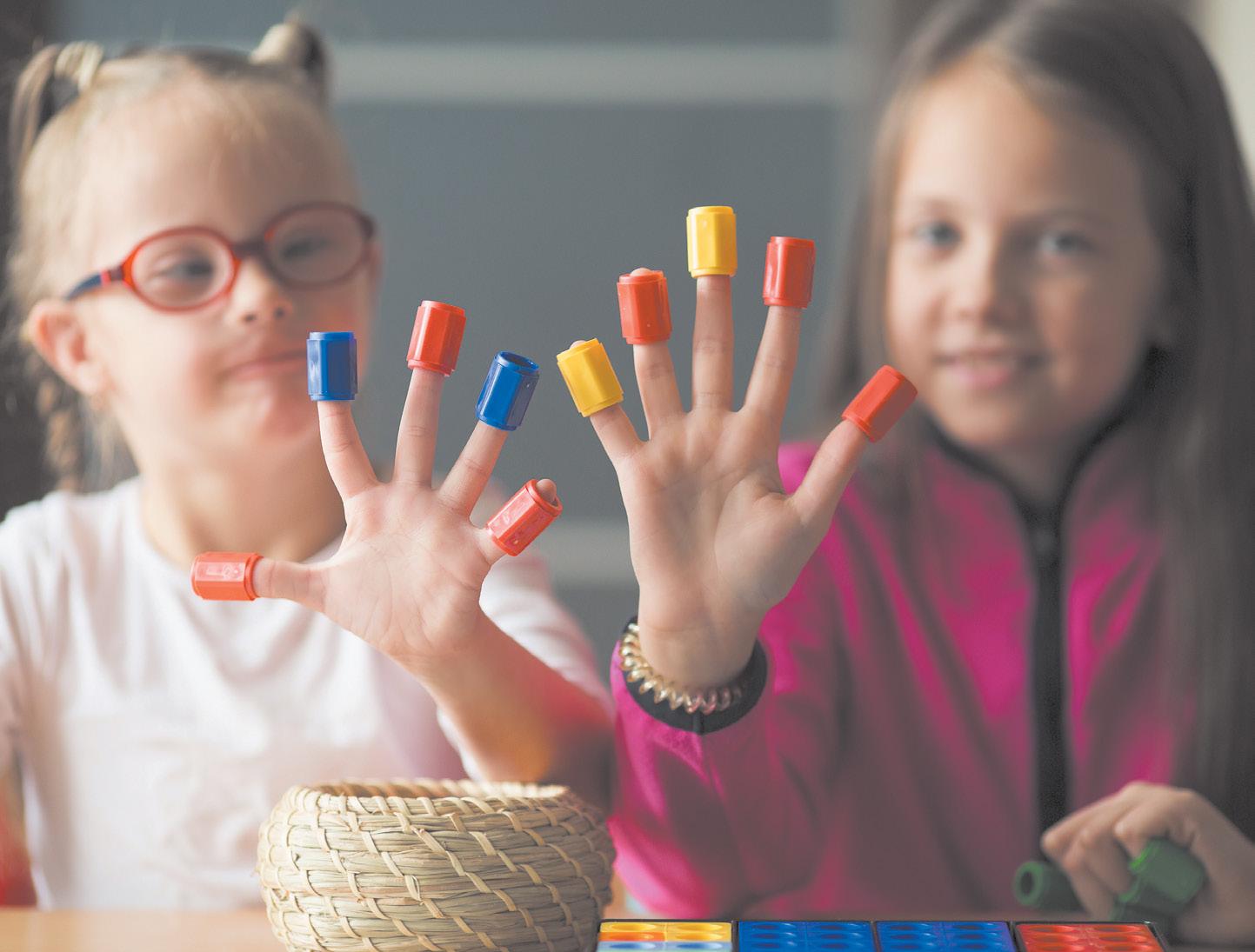
Tips for Playdates with Kids with Special Needs
Playdates are an important part of childhood. They offer time for kids to interact socially without the structure of school or extracurricular activities. They also help kids learn to share, socialize, and play freely while still having support from their parents as needed. Kids with special needs are no exception and benefit from playdates as much as their peers. While they may take a little more planning and patience, it is well worth the efforts for everyone involved. Here are some tips for hosting a playdate with kids with disabilities.
BE OPEN
Our natural reaction may be to avoid talking about any disabilities a child may have but it is better to address any questions or concerns beforehand so everyone is more comfortable and knows what to expect. “I am upfront and honest about my daughter before we go to anyone’s house for a playdate,” says Barb Walker-Shapiro, mom of six from Omaha, NE. “Her brain doesn’t work like other kids. She may have a seizure and
is prone to major meltdowns. I find that when other parents know what’s ‘wrong’ with my daughter, they are more tolerant and compassionate towards her.”
It is also a good idea to talk to your children openly about differences they may have with their friends. Explain that just because others may seem different or express their joy differently, it doesn’t mean they don’t enjoy playdates or making new friends as well. Prior to the playdate, it is also a good idea to check in with the other parents about whether there are any food allergies or restrictions and anything important you should know.
BE STRATEGIC
Prior to the playdate, have a discussion with the other parents about what would be the best location to have the playdate. For some, their own home is more comfortable and successful. For others, staying at home may encourage the child with special needs to say hello then retreat to their room while company visits. In this case, it may be better to go to a public place that everyone can en-
joy, such as a park, museum, or zoo. On the other hand, parents who have a child that is prone to running away or hiding may find a public place overwhelming. Discuss your plans with all the parents involved and come up with the best solution for everyone.
Another great strategy is to plan activities that unite the kids. Kids who struggle with talking to peers or sharing toys may find that a common interest helps them feel more at ease. Find out the interests of the kids you are hosting and offer an activity around one that excites all of those invited. Ideas could include a craft, a game, or visiting somewhere that fosters that interest. For example, if they are interested in nature, visit the Tifft Nature Preserve or go on a backyard scavenger hunt. If they are interested in tractors and farm animals, visit a farm, such as Becker Farms.
BE PATIENT
Whenever kids are involved, patience is important. Try to understand that kids may have different reactions to situations, things may not go exactly as expected, and that it may take some time for kids with special needs to warm up to the situation. Some children with special needs may prefer to participate in parallel play. Parallel play is when kids play beside each other, but do not interact with one another. Children who play alone during parallel play still enjoy the time together and are usually interested in what the other children are doing. If things do not go as planned, it is okay to cut the playdate short and try again in the future.
BE
INCLUSIVE
It is most important to note that kids with disabilities or special needs are just like anyone else; they want to interact with friends and be loved and appreciated. When hosting a playdate with kids with disabilities it’s important to greet them and interact with them as you would anyone else you meet. “Please say hi to my son. Smile at him, even if he doesn’t smile back,” says Marie Taylor, Olathe, KS mother of two. Even if the child is nonverbal or doesn’t seem to hear you,
36 WNY Family April 2024
it is important to speak to them. Angela Leever, special education teacher and mother of three, says “Encourage the parents and children to speak to the child with special needs, not about them. If the child with special needs does something your child isn’t happy with or that isn’t appropriate, allow them to use words to tell them. Sometimes that is more powerful than the adults intervening.”
BEUNDERSTANDING
Parenting is not easy and we all struggle with different challenges when it comes to our children. Ask the parent if they need help with anything prior to the playdate. “I almost always have a few extra things to carry so please don’t be shy about asking if I need help,” says Taylor. “I also need a lot of grace.” Try to be patient and understanding. The other parent may be overwhelmed or tired. It may have been challenging to get there. All parents have great days where everything goes as planned and tough days where it seems nothing does. Listen and offer a hand when needed and they will

It may take a little more planning and patience than the average playdate, but it is so worth it...
most likely offer the same in return.
The most important tip for having a playdate with a child who has special needs is just to have them. It may take a little more planning and patience than the average playdate, but it is so worth
it to both the parents and kids involved. Playdates offer a great chance for kids to interact with peers and make friends in a non-stressful way, and they are also a great time for parents to connect and build each other up as well.
Playdate Activities That Unite
Choosing activities that encourage common interests will help foster friendships. Here are some ideas:
Build something Legos, blocks, wooden train sets
Pick something they are both interested in And go do it
Arts and crafts
Go outside and play
Quiet stations for the quieter group
Set up puzzles, coloring sheets, books, blocks
Set up a sensory bin
Pick a neutral location Museum, park, or zoo
April 2024 WNY Family 37





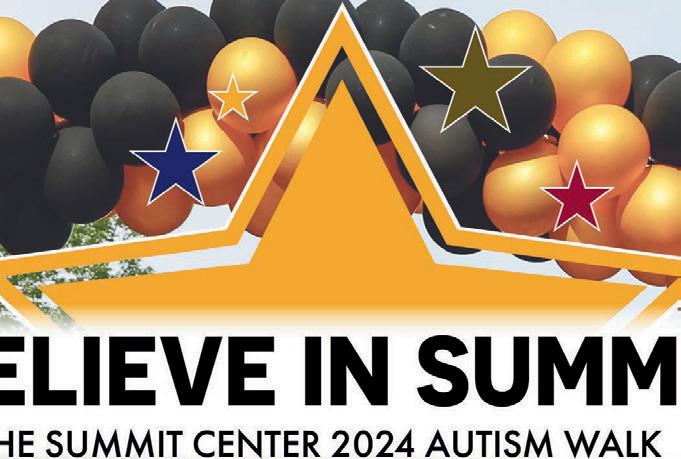
























BE PREPARED FOR THE END OF THE SCHOOL YEAR SLIDE continued...
the end-of-the-year songfest is going to be. Notice hasn’t come home? Check with the teacher or school secretary. They’re usually in the know. If a notice comes home or an email comes through with a class sharing or end-of-the-year hoopla, get it on the calendar right then. Maybe even on two calendars. As much as I like the calendar on my phone, I can’t give up my amazing wall calendar. You can even set reminders on your phone. These dates are important and out of the usual routine. Be ready. Knowledge is power.
6. Wash backpacks and lunchboxes.
By this point in the year, they’re pretty gross. Do yourself and your kids a favor and wash them now. This is also a great way to make sure they will make it until the very last day. Also, tell the kids to check lost and found for water bottles, sweatshirts, and anything they may have lost track of. (Better yet, swing by the school and check yourself!)
7. Get shopping.
Teacher gifts are handled differently everywhere. Find out how things are done and get shopping. What you will purchase isn’t much different now than it will be in a few months. This is an easy thing to check off your end-ofthe-year list. Get what you need. You can even keep it simple and get every teacher the same thing like a beach bag with a great read or a gift card. Wrap it up and put it in a designated place. Also, set up a phone or email reminder a week before the last day so you know where you put everything. You’ll be so glad you did.
8. Invite the family.
With graduations, Mother’s Day tea, and end-of-the-year assemblies, make sure you pass along important dates to grandparents or other special people who would want to come to celebrate. Giving them the heads up early will ensure you don’t forget to invite someone special.

9. Food stock up.
The last few weeks get crazy, but we all still need to eat. Make a double batch of whatever you’re cooking and put one in the freezer for an easy meal when the days are packed. Stocking up on packaged snacks and quick meals helps too. When you run home from work and school pick up to sports and have to go back out for a science fair, you’ll be glad you have dinner prepped. (The crock pot is your best friend here!) Stocking up is also a big help for packing lunches during the last weeks of school when the cabinets usually look pretty bare.




10. Pick one thing.
As a family, pick one thing you will look forward to doing when school gets out. It can be a day at the pool together or ice cream for breakfast. Have something relaxing you can look forward to doing together after all the craziness has passed. You will all be glad to have that special something to look forward to!
And a final word of encouragement for you fellow parents: You will all make it through this. No matter what the end of the year looks like, no matter how much chaos or calm you find, you will all make it through for another year.





































April 2024 WNY Family 39
















CAMPsSummer Special Advertising Section Find the Right Camp for Your Child 40 WNY Family April 2024 For Kids ages 4-12 Best Places To Work FinalistBuffalo Business First, 2023 Today’s families and staff choose Just for Kids! Before and After School Programs SUMMER CLUB LOCATIONS: Williamsville @ Maple East Elem. Cheektowaga @ Union East Elem. Sweet Home @ Willow Ridge Elem. Grand Island @ Kaegebein Elem. SUMMER DAY CAMPS Full and Half Day Rates Available Register Online: www.justforkidsonline.org Williamsville @ Maple East Elem. Cheektowaga @ Union East Elem. Sweet Home @ Willow Ridge Elem. Grand Island @ Kaegebein Elem. 716-639-8500 Junior Sailing Camp We Teach Sailing! Enrollment is Open, Sign Up Now! info@sail-buffalo.org 716-432-6589 www.sail-buffalo.org Sail Buffalo Sailing School Sail Buffalo Weekly Sessions Ages: 7 - 18






April 2024 WNY Family 41 CAMPsSummer Special Advertising Section Find the Right Camp for Your Child 1/2 Day Summer Literacy Camp & Individualized Literacy Tutoring 2 Summer Literacy Programs Offered! 716-645-2470 www.buffalo.edu/clari ub-clari@buffalo.edu Every little girl dreams of being a Princess. Make her dreams come true at the American Academy Princess Camp. Princess Camp 491 West Klein at Hopkins, Williamsville Call 716-688-4774 for more details The weeks of June 24th, July 1st, July 8th All Classes are Grouped by Ages 4-8 Our Princess Camp will enchant her with: Dance, Theatre Games, Etiquette, Tea Parties, Crafts, Princess Costumes, A Life Sized Cinderella Carriage & A Visit From Prince Charming Every Friday! daviddemarie.com • 716.510.2531 • 10151 Main St. Clarence, NY David De Marie Dance 3 WEEK CAMP MOMMY/ME: AGES 18MO - AGE 2.5: $50 Thurs. AM - 7/18, 7/25, 8/1: 9:00 - 9:30 Tues. PM - 7/16, 7/23, 7/30: 4:00 - 4:30 TOTS BOP: AGES 2.5 - 3 : $60 Thurs. AM - 7/18, 7/25, 8/1: 9:45 - 10:30 Tues. PM - 7/16, 7/23, 7/30: 4:45 - 5:30 KINDER DANCERS: AGES 4 - 5: $60 Thurs. AM - 7/18, 7/25, 8/1: 10:30 - 11:15 Tues. PM - 7/16, 7/23, 7/30: 5:30 - 6:15 WEEKLY THEMES FOR TOTS & KINDERS! REGISTER ONLINE TODAY! CLASSES WILL FILL Be sure to check out the website for more exciting summer offerings! ~ Summer 2024 ~ Tots-Kinder Fairytale Dance Camp







































42 WNY Family April 2024 CAMPs Summer Special Advertising Section Find the Right Camp for Your Child Learning Competitions Crafts Re a d y, Set C A M P ! Boost your enrollment in 2024 through WNY Family’s Advertising Space Reservation Deadlines: For more info call 716-836-3486 April ......................... Friday, March 8 May Wednesday, April 10 June ............................ Friday, May 10 July Monday, June 10 CENTER STAGE DANCE STUDIO - Certified member of Dance Educators of America★ 716-634-3395 ★ www.csds .dance 4837 Union Rd., Cheektowaga (Near Cleveland Dr.) Summer Dance Coming this July and August! Details will be announced soon. 5 Studios - Ample Parking ACRO CAMP Every Wednesday from July 10th through August 21st CLASSES OFFERED IN Jazz, Tap, Ballet, Hip Hop and Acro Beginner Acro at 5:30pm Intermediate/Advanced Acro at 6:30pm Musical Theatre Camp Dance Intensive - ADD ON to Musical Theatre Camp Photography Camp Cooking Camp STEAM Camp Lacrosse Camp Entrepreneurship Camp Journalism Camp Leadership and Creativity Camp Vollyball Camp Basketball Camp Crew Camp FlaG Football Camp Soccer Camp Taylor Swift Camp! Spend your Summer at MSM! Register Today! Use the QR code below to learn more about dates, times and locations for our awesome offerings for Summer 2024! at Mount St. Mary Academy ★ ★ ★ ★ ★ ★ ★ ★ ★ ★ ★ ★ ★ ★ ★


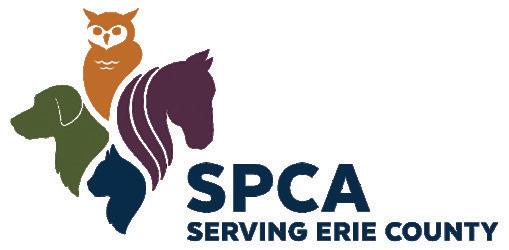
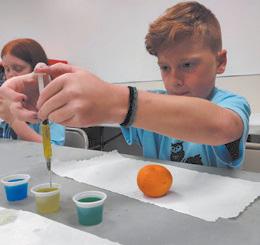




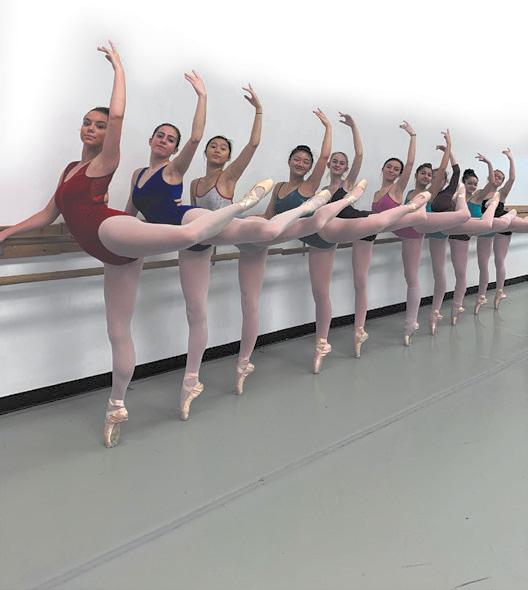


























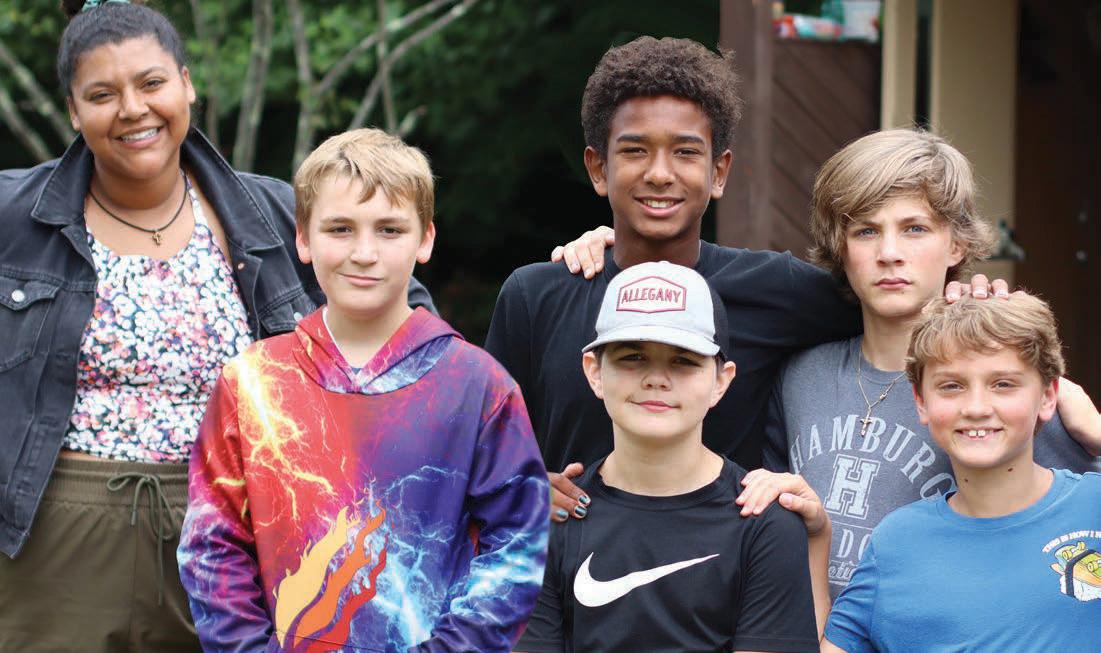



April 2024 WNY Family 43 Skibbereen Farm 5142 Bussendorfer Road • Orchard Park, NY 14127 www.skibbereenfarm.com • 716-648-1908 HORSE CAMP at Skibbereen Farm • Learn basic riding skills • Safety rules around horses • Horse care • Saddlery • Basic first aid June through August • 9am-1pm Registration Form Online Cost: $425/Session Summer and School Break camps are available! Camp ages: 4 – 13 yrs. 300 Harlem Rd., West Seneca, NY 14224 • 716-875-7360 For more information, visit YourSPCA.org To register for Break Camp To register for Summer Camp 949 Englewood • Buffalo, NY 14223 Official School of the Greater Buffalo Youth Ballet 835-3585 or 796-9102 | www.rabanddance.com Summer DANCE Intensive July 8 - Aug. 2, 2024 Ages 7yrs - 18yrs Monday - Friday 10am - 4pm Exciting Guest Teachers!!! RESERVE YOUR SPOT NOW! with DANCE this Summer Fall in Love August Pirates & Princess CAMP August 12 - 15, 2024 Ages 2 – 6














44 WNY Family April 2024 70 Weiss Ave. • Orchard Park/West Seneca (Near Duff’s & Leisure Rinks) • 677-0338 • Mini Camp - Ages 5-12 T9:30am - Noon on M/W; 12:30pm - 3pm on M/W or T/TH • Quality Gymnastics: Ages 1-18yrs Weekly Themes • Trampoline & Tumbling Classes: 7-18yrs • Open Tumble/Cheer Class July/Aug. - Mon. 8:50-9:45pm • July/August Open Workouts - Wed. 7:15-9pm www.gymnastics-unlimited.net SUMMER 2024 Summer 8 WEEK PROGRAM Starts July 1st See website www.zpac.biz for classes
15th, 16th & 17th Ages 1.5 - Adult are welcome! Competition Team (New & Returning) MUST take all 3 days For more information, call (716) 608-1010 or visit: www.zpac.biz
Team New & Returning Members Audition
July 18th 4:00-8:30pm
Intensive Fall Open Houses: August 25th from 1-4pm August 28th from 5-8pm www.fourseasonsfamily.com four seasons Camp @ 9 mile island 1 Orbit Drive Nine Mile Island • Amherst FOUR SE ASONS CHILDCARE CENTER & PRESCHOOL 1639N.FrenchRd.,Getzville,NY14068 EARLY ENROLLMENT SPECIALS Call 568-1140 • Water Activities • Hiking • Arts & Crafts • In-house visitors • Great Outdoor Fun and much more! Register online at WSRC.org or call 716-881-9797 Summer Crew Camp for youth ages 11-16 Full Day and Half Day Sessions Available for June, July and August! Financial Assistance Available
July
Competition
Thursday,
Summer
Unboxing Fun and Learning: Crates for Kids!
RAISING DIGITAL KIDS
— by Mike Daugherty
Crate subscriptions are an innovative and engaging solution for both education and entertainment, offering a unique blend of learning and fun. These curated boxes deliver a range of activities and themes that not only alleviate boredom but also foster new skills and knowledge. Whether it’s exploring STEM concepts, cooking, or arts and crafts, each crate is designed to spark curiosity and excitement, turning any moment into an opportunity for discovery and joy. Let’s look at some options for children of all ages and interests.
STEM CRATES
KiwiCo
STEM activities are ideal for kids, and KiwiCo.com offers fantastic premade crates focusing on science, math, engineering, and art/design, designed for independent exploration with minimal parental help. Options include single purchases or a subscription service, where each month presents a new and exciting project, enhancing the experience with an element of surprise. My daughter has been a subscriber for two years and remains enthusiastic about each new crate, appreciating their quality and diversity. We were so pleased with her experience that we also subscribed for her older brother. KiwiCo offers these enriching educational boxes for $19.99 per month, with customization available for topic selection and age-appropriate content, ensuring a tailored educational experience for every child.
Crunch Labs
CrunchLabs is a dynamic monthly STEM toy subscription box designed for kids aged 8-12+, created by Mark Rober, a former NASA engineer and popular YouTuber. Each month, the subscription provides a new build-ityourself toy that comes with a comprehensive set of parts and tools needed for assembly. The box aims to inspire kids to think like engineers, offering a blend of hands-on building with educational content. An exclusive feature is the 15 to 30-minute educational video from Mark
Rober that accompanies each box, offering step-by-step guidance and exploring the engineering concepts behind the toy. The subscription offers various plans, including monthly, quarterly, and annual options, with prices ranging from $24.95 to $29.95 per box, depending on the subscription length. There’s also a special offer where you can get two months free with an annual subscription.
Creation Crate
For more advanced kids, consider the Creation Crate. The Creation Crate has a curriculum attached to each box that focuses on electronics, circuitry, and computer programming. The electronics curriculum is an 18-project pathway that progressively becomes more challenging. Students will gain a deeper understanding by creating intricate projects like an RFID reader and a laser tripwire transmitter. A Creation Crate monthly subscription costs $29.99, but various options allow parents to purchase a singular project to start. Check out CreationCrate.com for more information.
READING CRATES
Literati Book Club
Literati Book Club offers a unique and curated reading experience for both adults and children. For kids, Literati provides award-winning book clubs for ages 0-12, delivering five new and unique kids’ books monthly. Parents have the option to purchase the books they like and return the rest. The subscription is $9.95 per month plus the cost of any books you choose to keep. The club aims to spark excitement around reading with expertly-curated selections that cater to various reading levels and interests.
Amazon Book Box
Amazon Book Box is a subscription service designed for Pre-K and elementary readers, providing two new hardcover books each month. It focuses on building a quality book collection for young readers, featuring a mix of classics and new releases. Subscribers can select books suited to their age level and
have the option to adjust their choices monthly to avoid receiving duplicates.
OwlCrate
OwlCrate is a popular subscription box for young adults and middle-toupper elementary school readers. Each month, subscribers receive a new book along with a variety of themed goodies. These books are fresh releases from publishers, reducing the chances of receiving a duplicate if you’re an avid reader. The original OwlCrate targets young adults, while OwlCrate Jr. is designed for younger readers, often featuring a waitlist due to its popularity.
COOKING CRATES
KidStir
Cooking with your children is a delightful way to combat boredom and impart essential life skills. Opt for KidStir Cooking Kits instead of the usual online recipe hunt. These kits, themed around fun activities like camping or a Mexican fiesta, aim to boost kids’ culinary confidence and help them create a lasting recipe collection. Each kit is packed with unique monthly recipes, engaging games, handy utensils, and more, encouraging kids to learn about food by shopping for ingredients themselves. Start with a $4.99 trial, then explore monthly or longer-term subscriptions for additional savings at kidstir.com/.
Little Sous
Little Sous is a monthly culinary subscription box designed for kids, aiming to educate and engage them in the art of cooking and global food culture. The subscription includes 6-8 hours of themed, screen-free cooking lessons and activities. Each box comes with hand-illustrated lessons and recipes, science and art-focused activities, kid-safe kitchen tools, a jumbo cultural coloring poster, and collectible vinyl stickers. It’s tailored for kids aged 5 and up, with younger children requiring more adult collaboration, while those 8 and older can handle most tasks independently. The subscription options vary, offering monthly, 6-month, and 12-month plans, with prices ranging from $19.99 to $24.99 per month, depending on the subscription length.
Kids’ Young Chefs’ Club
Kids’ Young Chefs’ Club from America’s Test Kitchen offers a similar subscription. The boxes from Kids’ Young Chefs’ Club contain recipes tested explicitly by kids for kids. These boxes encourage children to customize their experience by tweaking a recipe to continued on page 55
April 2024 WNY Family 45





periments that you can do with the whole family. Try the experiments under the heading Superhero Science. Perhaps Scary Science is more interesting. Do Bubbles, Bubbles, Bubbles, or Just Add Water interest you? There are more experiments under Glitz and Glam, Food Science, Let’s Go Outside, and Science with Friends. Simple directions and ingredients with graphs and illustrations make this accessible for all ages.

We often take birds for granted mainly because they are all around us. That includes our lack of awareness of our surroundings. It is not only time to wake up from our winter slumber, but to wake up our senses to what nature has to offer us. In this way we wake up to the relationships we have with family, friends, and the world around us. All of this is there waiting for us to “spring forth” and join the celebration of this energetic season!
Dr. Donna Phillips is an associate professor in the College of Education at Niagara University where her specialty is literacy and children’s literature. She lives on Grand Island, NY and is the mother of two adult children and the grandmother of one.
DEAR TEACHER continued...
have the motivation, ability to focus, and time to practice. This is typically between the ages of 7 and 9. However, children of any age can benefit from taking voice lessons.
Overscheduling
Children in Activities Should Be Avoided
Overscheduling can lead to a whole family being overstressed. The golden rule for scheduling activities involving sports is one sport per season for elementary school. The younger children are, the more time that they should spend in unstructured play. Studies show that most teenagers may be involved in two to three activities during the week taking less than a total time of 5 hours. Overinvolvement for this age is not typically a negative unless it exceeds 20 hours a week.

Parents should send questions and comments to dearteacher@dearteacher.com, and visit the dearteacher.com website to learn more about helping their children succeed in school.
46 WNY Family April 2024
PICK OF THE LITERATURE continued...
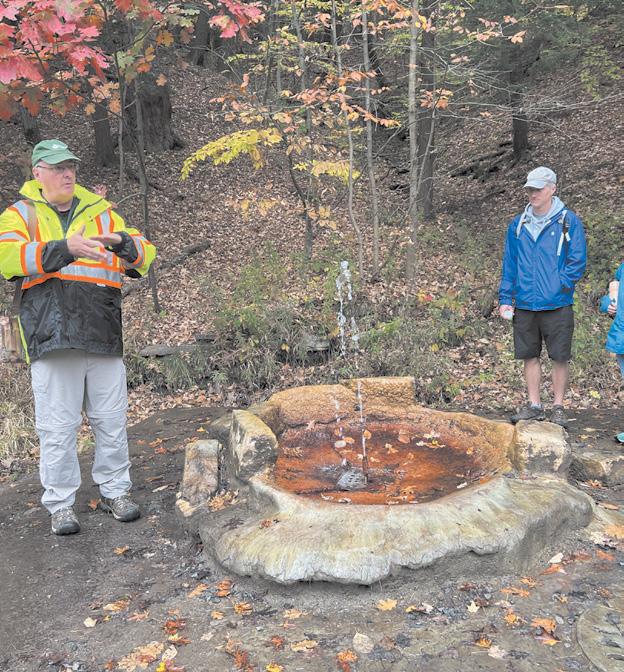

FAMILY TRAVEL
— by Deborah Williams

For hundreds of years Native Americans were drawn to the Saratoga Springs area’s once secret mineral springs. Once the word was out, even George Washington was a fan.
The most famous Revolutionary War battle that ended with the total surrender of the British was fought here. It was the turning point of the war and its outcome reverberated on the world stage.
It is home to the oldest organized sporting venue of any kind in the country—the Saratoga Race Course, dating back to 1863.
And if all this history is not enough to plan a visit to this fabled northern New York town, it has laid claim to being the birthplace of the potato chip, otherwise known as the Saratoga chip.
The nearby Champlain Canal which connects to the Erie Canal is the oldest continuously operating canal in the country.
Just six miles from Saratoga Springs is the sparkling 4.5-mile-long Saratoga Lake that has it all for water lovers: waterfront park, public beach, boat tours, boat rentals, and good fishing.
Saratoga Springs is known for its historic landmark state park, distinctive architecture, a handful of museums dedicated to horse racing, automobiles, military history, dance, history, and fun children’s play, as well as Saratoga National Historical Park that illuminates one of history’s most important battles.
Saratoga is a Mohawk word meaning “place of swift waters.” Some historians believe that Native Americans discovered the mineral springs running under swampland as early as the 14th century and made them a pilgrimage site. They called them “smelly water.”
Visitors are invited to come along on a free tasting and tour of five springs in Saratoga Springs State Park led by Ken Chaisson, park educator. His talk was full of history and lore about the springs. He brought along paper cups for the tastings with warnings about

possible strong taste of several springs. Waters travel through shale and limestone, absorbing minerals to become the bubbling, salty and sometimes pungent water that made Saratoga famous.
People come from near and far to fill their water jugs with Saratoga water which many believe carry medicinal benefits. The bottled water is also available in local stores.
It is possible “to take the waters” at the Roosevelt Baths & Spa, one of the imposing buildings in the Saratoga Spa State Park, a national landmark. Opened in 1935, services include a private soak
in the naturally effervescent water, massages, facials, and body treatments such as mud wraps and sugar scrubs.
The 2,300-acre state park offers a swimming pool complex, tennis courts, golf course, ice skating in winter, trails for hiking and biking, and the Saratoga Performing Arts Center (SPAC). The center is the summer home of the New York City Ballet and the Philadelphia Orchestra. The gracious and elegant Gideon Putnam Hotel and Conference Center is also in the park.
Saratoga Springs still retains much of its earlier charm. Broadway, the city’s main street, has been named one of the five best main streets in the United States by the National Trust for Historic Preservation.
Just off Broadway is Congress Park, a perfect place for a picnic, for walking, for concerts, art shows, festivals, and other special events. Bring your cup to try out the waters from the mineral springs in the park. During the summer, take a ride on the historic wooden carousel.
Potato chips have long been America’s favorite snack food thanks to a Saratoga chef. During the summer of 1853, a guest at the town’s elegant Moon Lake Lodge found Chef George Crum’s French fries too thick for his liking. He demanded a thinner batch and then rejected the next batch. Exasperated, Crum decided to rile the guest by producing potatoes too thin and too crisp to skewer with a fork.
continued on page 48
April 2024 WNY Family 47
Saratoga Race Course
Childrens’ Museum
Free tasting and tour
Battle Reinactment by Tom Stock

The plan backfired. The guest was ecstatic over the paper-thin potatoes and other guests requested the new dish. They began to appear on the menu as Saratoga Chips and thus potato chips were born.
Beyond the potato chip, Saratoga Springs has long been known for its lively restaurant scene. We sampled several of the town’s most famous: Hattie’s Restaurant, Mrs. London’s Bakery Café and The Olde Bryan Inn—all winners.
Established in 1938, Hattie’s Restaurant is famous for its fine southern home cooking served in a friendly downhome atmosphere. Mrs. London’s has had a long reputation for its delicious breads, desserts, and pastries and has been featured in national media. It would be right at home on the right bank of Paris.
The Olde Bryan Inn is full of history and even some ghosts. An inn since 1773, it is named for the first permanent local settler. The spring across the road was a big attraction. It is a cozy place serving traditional dishes that would appeal to the Revolutionary War officers.
Start your day with breakfast at the track, a longtime Saratoga tradition. It is served on the terrace overlooking the track each morning—between 7 and 9:30—while jockeys exercise their mounts. This tradition began more than a century ago when partying racehorse owners ended their all-night sprees with an eye-opener at the track before going home to bed.
When the thoroughbreds return, so does an elegance of a bygone era. The
season is short and sweet in Saratoga. The month of August is devoted to the steed. The entire town is transformed and focuses on one pastime, one sport. The finest thoroughbreds in the country are here for the season along with the rich and famous.
The course itself is gorgeous with putting green turf and carefully manicured trees and hedges. There is even a lake in the infield and a canoe.
Of course, prices skyrocket during the thoroughbred racing season. So, if horses are not a top priority, visit outside the August season. The harness racing season runs from late January to November with a short break in April and prices are normal during harness racing times.

Saratoga National Historical Park in Stillwater, a few miles from Saratoga Springs, is a must see for the whole family. Two fierce battles in September and October 1777, led to the first-ever surrender of a British army, marked the war’s turning point, and changed the world forever.
Every American schoolchild learns of the surrender of General John “Gentleman Johnny” Burgoyne to the colonists at Saratoga on October 17, 1777. It was a monumental day for the Americans. For the first time in history a British officer ceremoniously surrendered his sword. The entire British Army — some 6,000 men—stacked their weapons along the west bank of the Hudson River.
Burgoyne’s surrender revealed British weakness and Britain’s rivals pounced. France at last publicly recognized an independent United States and allied with the new nation in 1778. This led to open war between Great Britain and France and other wars broke out
challenging Britain’s worldwide dominance. These wars helped convince Britain to make peace with the United States in 1783.
Start your visit at the visitor’s center. Here you can pick up a battlefield brochure and see the park film, attend a ranger program, and learn about the importance of the Battles of Saratoga. The small museum gives a feel for the human dimensions of 18th century warfare. There are weapons, clay pipes, crude eating tools, even a toothbrush owned by colonial soldiers.
It is also the place to pick up an activity book for the Junior Ranger program. The program is designed for ages 5-13 although all ages can participate. After completing activities, junior rangers take the oath to “Explore, Learn, Protect.” The junior ranger promises to protect parks, continue to learn about parks and share their ranger story. Upon completion, children receive a Saratoga Junior Ranger badge.
Ride along the ten-mile battlefield tour road. During the summer, living history encampments are regularly scheduled at the Nielson Farm, which American generals used as their headquarters. The farmhouse still stands.
One of the more popular sites is Number 7, the Breymann Redoubt. General Benedict Arnold was injured in the leg here just as Americans captured the position. The so-called Boot Monument immortalizes the incident. The only such monument like it in the country, it bears neither the likeness nor the name of the commemorated hero—reflecting Arnold’s later reputation as a traitor. Had he died here from his wounds he would have gone down in history as one of American’s finest generals and patriots.
The battlefield is the largest part of the park but there are four other attractions: Victory Woods, Saratoga Monument, Saratoga Surrender Site, and Schuyler House. The 22-acre Victory Woods mark the final encampment site for the British Army prior to their surrender to American forces. There is an accessible half mile boardwalk with interpretive signs.
Saratoga Monument is a 155-foot obelisk standing on Burgoyne’s final en-
48 WNY Family April 2024
FAMILY TRAVEL continued...
The Olde Bryan Inn
Battle Reinactment by Tom Stock

campment. Built by citizens, its cornerstone was laid on October 17, 1877—the centennial of the surrender.
Schuyler House was the hub of Gen. Philip Schuyler’s business operations and from 1702 to 1837 it was occupied by five generations of Schuylers, including Philip and his wife Catherine.
Travel Tip of the Month: For information on Saratoga Springs visit discoversaratoga.org or call 518-584-1531.
There is a wide range of accommodations in town. A good choice for families including dogs is the Holiday Inn Saratoga Springs. It is within walking distance to Congress Park, the Saratoga Race Track and many restaurants. It is the only area hotel with both indoor and outdoor heated pools. Up to two kids ages 11 and under eat free per adult ordering from the main menu at the Holiday Inn restaurant. Visit ihg.com or call 888-HOLIDAY for more information and reservations.
Be sure to download the National Park Service app before coming to the park. Reception is difficult in the Visitors Center. Search for Saratoga National Historical Park, select it and then click on self-guided tours. There is even the Wilkinson Trail Kid’s Audio Tour narrated completely by kids.
Deborah Williams lives in Holland, NY and is a veteran travel writer whose work has appeared in national and international publications. She is the recipient of the Society of American Travel Writers’ Lowell Thomas Gold Travel Writing Award.






April 2024 WNY Family 49
Saratoga Monument

Family Movie Options: In Theaters and Streaming Online
Kung Fu Panda 4
Theaters
Rating Overall Violence Sex Profanity Alcohol/Drugs
PG B B A A A


Dune: Part 2

It’s time for Po to retire as Dragon Warrior and assume a new role as a Spiritual Leader. Reluctant to make the change, Po takes on one final mission – a quest to defeat The Chameleon, a mysterious shapeshifting villain. This film isn’t as good as the one that kicked off the franchise, but it ’s a big hit with kids and will even have parents laughing from time to time. The script has good messages about accepting change and doing the right thing. Best of all, Jack Black brings his usual charisma and hilarity to his starring role. Photo ©Universal Pictures
Theaters
Rating Overall Violence Sex Profanity Alcohol/Drugs
PG-13 B- C- B B- A
Paul Atreides wants revenge against the Harkonnens responsible for the death of his father. Paul’s mother yearns for him to fulfill an ancient prophecy that will see him become Emperor Caught between these desires, Paul must determine if he will claim his destiny and cause billions of deaths or let his father’s killers go free. This sequel maintains the immersive worldbuilding of the first film and offers expanded character development. Parents should note a fair bit of fantasy violence but the film will please genre fans. Photo ©Warner Bros Pictures
Cabrini Theaters

One Life
Rating Overall Violence Sex Profanity Alcohol/Drugs
PG-13 A- C+ A- B+ C
Sickly and frail, Mother Cabrini is determined to fulfill her dream of founding orphanages and hospitals When the Pope assigns her to New York City, she is appalled by the conditions in which Italian immigrants live. Fighting sexism and bigotry within the Church and City Hall, she employs both love and strategy to advocate for the innate dignity of the poor This uplifting film will please anyone who enjoys tales of goodness, compassion, and courage Photo ©Angel Studios
Theaters
Rating Overall Violence Sex Profanity Alcohol/Drugs
PG A B A- B+ C+


Horrified at the conditions faced by refugees in Prague, British businessman Nicholas Winton throws himself into the effort to save Jewish children from the Nazis, finding homes in England for 669 of them. Decades later, a TV show gives him the chance to see the results of his efforts...This is a powerful story of goodness, humanitarianism, and decency. Wartime violence is sanitized and this movie is recommended for families with teens. Photo ©Warner Bros Pictures
PG-13 B- C A A- A


With her people freezing and on the brink of famine, Elodie agrees to wed Prince Henry of the wealthy kingdom of Aurea. But Elodie will never be queen: she is to be sacrificed to a dragon with a centuries-long grudge. This is a well-imagined YA fantasy film, boasting meticulous sets and detailed costumes. It is also violent, featuring frequent bursts of dragon fire plus numerous scenes of sword fighting and physical combat. The tale offers messages of love, courage, self-sacrifice, and persistence but it also veers from mercy into vengeance
Detailed reviews available at www.parentpreviews.com
Photo ©Netflix
April 2024 WNY Family 51
Damsel Netflix Rating Overall Violence Sex Profanity Alcohol/Drugs
TWEENS & TEENS
— by Katy M. Clark
The Summer After He Turns 16

Iremember those sleepless nights when I was in my third trimester of pregnancy. How I could not get comfortable no matter which way I turned my big belly.
“It’s preparing you for when the baby comes,” the wise mothers who had gone before me said. “You’re learning how to function on less sleep so you’ll be more accustomed to it after you have the baby,” touted the pregnancy books.
I never fully embraced this thinking, though. I’m not sure that getting less sleep made me anything other than cranky.
But my experience during the third trimester seems relevant now that I’m in the summer after my teen turned 16. Because I feel that somehow this summer is preparing me for what comes next in my motherhood journey. For when my son becomes a man.
The summer after 16 is what I call that first batch of long, free-from-school days after a teen turns 16. It is different than the summers before because with age 16 comes the ability to drive—and drive away.
When I see my teen in a car, driving away from me, I think maybe it’s preparing me for the day he drives away to his new life and won’t be coming back to his old one with me, his dad, and his sister.
The summer after 16 means sometimes he gets into a friend’s car and they drive away. It means I pray every time he leaves the driveway.
He hangs out with his friends more often during the summer after 16. He does not hang out with me and his little sister so much. That’s the way it should be, but I can’t help missing those times in summers past when he happily went on a bike ride or spent the day at the lake with us. I know my daughter misses him, too.
The summer after 16 brings a new job. When he leaves for his job, I see him becoming a person who operates independently from me. He drives there himself. He puts gas in the car, using the money he earns from the job. I’m surprised by how this makes me feel: relieved that I don’t have to drive him everywhere and yet sad that I don’t have to drive him everywhere.
The summer after 16 means he sleeps in. And in and in. Get up, I think. Wake up, I urge. I want to see you, talk to you or spend time with you in the same room even if we are just both sitting on the couch, eating breakfast and checking our phones.
And when he wakes up at noon? How is it possible that he looks bigger than just yesterday, that he grew more overnight. He is changing physically before my eyes during the summer after 16.
The summer after 16 is going by too fast. There are hours spent at his summer job. Time spent sleeping in and then going out with his friends. All of these are moments that I am not with him.
The summer after 16, I realize with growing awareness, does have something in common with that last trimester of pregnancy. It is preparing me for the summers to come when he will be a grown man, not my little man.
So, this summer I will let him drive away, happy that at least he will come back later. I will savor when he comes home from work, knowing that soon enough he’ll come home to his own house, not mine. I will treasure that I know the friends he hangs out with, as one day I may not know who they are.
I will enjoy each moment of the summer after 16, knowing that I am lucky enough to be the one he calls Mom during this season, each and every day.
This piece originally appeared on Moms of Tweens and Teens.
Katy M. Clark is an award-winning writer who has been published nationally in Pregnancy and regionally in Ann Arbor Family, Atlanta Parent, and many more. Her essays have appeared on sites including Scary Mommy, Your Teen for Parents, and SheKnows Parenting. Her blog, which celebrates her imperfections as a mom, is ExperiencedBadMom.com.
52 WNY Family April 2024
— by Meagan Ruffing

IA Fresh Start
was helping my 10-year-old daughter get ready for bed the other night when she said something that stopped me in my tracks. She said, “Mom, it’s like a new start.” She was referring to the recent news of her dad getting remarried and their upcoming move to a new town. I was struck by the sound of hope in her sweet little voice, but also struggling inside to be as positive as her. I was both happy for her and sad for me. The idea of my children not being in the same home as me all the time was something I had grieved five years ago when I got divorced. This felt like I was grieving all over again with the news of them moving farther away. It didn’t feel like a fresh start to me. It felt unfair.
I found myself holding on to her positive outlook on things and decided to get curious about why I was feeling that way, rather than sitting in the unfairness of it all. I knew I needed to embrace what was coming while feeling what I needed to feel. Simply put, I had to give myself a fresh start in the way that I was approaching things as a single mom. I had to really grieve the old and celebrate the new so that I could show up for my daughter as a supportive person. Being genuine and authentic while you’re hurting is a hard thing to do. However, I kept replaying my daughter’s voice in my head and decided on
what my fresh start would look like.
If you’re newly divorced, in the middle of a divorce, or farther along in your years as a single mom, I encourage you to define what your fresh start will be. It may look different than mine and that’s okay. The important thing is to shift your attitude and perspective towards the future rather than staying in the past. Focusing on what you want your life to look like, the type of people you want around you, and the goals you have for yourself, will help you keep going in the right direction. These are things I did when I found myself ruminating on past hurts and feeling stuck.
1. I went on a walk every day for 60 days. I have no idea why I picked the number 60, other than it just felt right. I bought a new pair of ear buds, downloaded some new audiobooks, and started trekking through the trails around my house. Not only did I feel a sense of accomplishment, but I also lost a few pounds.
2. I did nice things for other people so I could focus on something other than myself. I surprised my neighbors with flowers and sent funny cards in the mail to long distance friends.
3. I started putting more effort into making my daughter’s lunch for school. I recognized that it made me happy to write her notes every day, so I found some artsy things to spruce up her
lunchbox. Packing her lunch used to feel like one more thing on my to do list, but I have started to look forward to it since establishing my fresh start.
4. My self-care became non-negotiable. Instead of looking at naps, brunch with friends, or coffee dates as things that needed to be scheduled all the time, I approached my kid-less weekends with a more laissez-faire attitude and allowed myself to go with the flow. This approach has given me more balance between how structured I am during the work week and how much more relaxed I can be on the weekends.
5. I ramped up my personal therapy appointments. I am used to seeing my therapist on a ‘needs’ basis but decided to start scheduling more regularly to help with accountability. I don’t always feel like I have a lot to talk about, but I’ve noticed it helps me stay focused on my healing and moving forward.
6. I bought more plants to put inside my house. I had a plethora of fake ones here and there but when a friend gifted me a live plant for my birthday, I felt awakened. I looked over at that plant on my kitchen table every morning while I made my coffee and smiled. I decided I would buy another, bigger plant to put near my front door. These plants have become a visual reminder for me that I can have a fresh start each day.
7. I make to-do lists when I’m feeling overwhelmed and sad. If I have down days, and yes, I still do, I make a to-do list to help organize my thoughts. It feels less stressful and more helpful than letting all the things ruminate in my head.
Your fresh start might be making it through the day and heading into the next. Divorce and single parenting can show up differently for everyone. Remember to notice what is coming up for you, be curious about it, and decide how you will approach your fresh start.
Meagan Ruffing is a parenting journalist and marriage and family therapist. She is looking forward to many more fresh starts this spring.
April 2024 WNY Family 53 SINGLE PARENTING

5 Cozy Ways to Add Warmth Cook with Heart Health in Mind
(Family Features)
Healthy eating doesn’t have to be difficult or require you to take favorite meals off your family’s menu. In fact, making smart choices when cooking at home can give you more control over the types of tasty, heart-healthy dishes you put on the table.
High cholesterol is one of the major controllable risk factors for heart disease and stroke, with about 38% of American adults diagnosed with high cholesterol, according to the American Heart Association. These cooking tips can help you prepare heart-healthy meals that could help improve cholesterol levels by reducing excess saturated fat and trans fat.
Cook Fresh Vegetables the HeartHealthy Way
Roasting, steaming, grilling or baking can help bring out the natural flavors of vegetables. Adding herbs and spices can also help make veggies tastier, including combinations like basil with tomatoes, oregano with zucchini, dill with green beans or rosemary with peas and cauliflower.
Reduce Saturated Fat in Meat and Poultry
The amount of saturated fat in meats can vary widely, depending on the cut and how it’s prepared. Opt for poultry and fish over red meat and look for lean cuts of meat with minimal visible fat, which should be trimmed away before cooking. Also limit processed meats such as sausage, bologna, salami and hot dogs, which are often high in calories, saturated fat and sodium.
Use Liquid Vegetable Oils in Place of Solid Fats
Some fats are better for you than others. Liquid vegetable oils such as canola, safflower, sunflower, soybean and olive oil can often be used instead of
solid fats, such as butter, lard or shortening. If you must use margarine, try the soft or liquid kind.
Find more heart-healthy recipes and tips for lowering cholesterol at heart.org/ cholesterol.
Grilled Tequila-Lime Chicken with Grilled Asparagus
Recipe courtesy of the American Heart Association
Servings: 4
1/4 cup tequila or white vinegar
2 teaspoons lime zest
1/2 cup fresh lime juice
2 medium garlic cloves, minced 1 tablespoon chipotle pepper canned in adobo sauce, minced, plus 2 tablespoons adobo sauce
1 1/2 pounds boneless, skinless chicken breasts, fat discarded Nonstick cooking spray
3 bunches asparagus spears, trimmed 1/4 teaspoon salt
1/2 teaspoon black pepper, divided 2 tablespoons canola oil or corn oil
In small bowl, stir tequila, lime zest, lime juice, garlic, chipotle pepper and adobo sauce. Pour into large resealable plastic bag. Add chicken and seal bag tightly; turn bag to coat. Refrigerate 2-12 hours. Preheat grill to medium-high heat. Lightly spray grates with nonstick cooking spray.
In large dish, sprinkle asparagus with salt and 1/4 teaspoon pepper. Drizzle with oil. Turn asparagus over to coat. Remove chicken from marinade. Discard marinade and wipe most of it off chicken. Sprinkle chicken with remaining pepper.
Grill 8-12 minutes, or until chicken is no longer pink in center. Transfer to plate and cover with aluminum foil.

Place asparagus on grill, facing opposite direction of grates. Grill 7 minutes, or until tender crisp.
Serve asparagus with chicken.
Frozen Yogurt Bark
Recipe courtesy of the American Heart Association
Servings: 8
1 1/2 cups 2% low-fat plain Greek yogurt
2 tablespoons honey
2 tablespoons chopped, unsalted almonds
1/2 cup chopped mango
1/4 cup blackberries or raspberries
1/2 cup blueberries
In medium bowl, mix yogurt and honey. Line 9-by-13-inch baking dish with parchment paper. Use spatula or knife to spread yogurt over entire bottom of dish. Pour chopped nuts over yogurt. Use fingers to slightly press into yogurt. Top yogurt with mango, blackberries and blueberries and slightly press into yogurt.
Cover with plastic wrap or foil and place in freezer overnight.
To serve: Lift parchment paper from baking dish onto cutting board. Use hands to break bark into pieces.
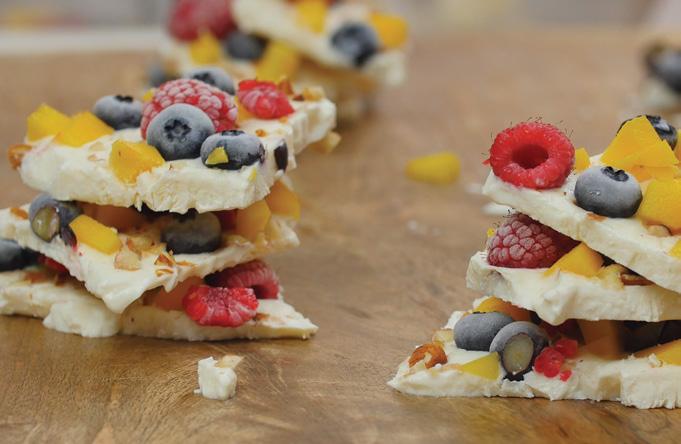
54 WNY Family April 2024
THE KIDDIE GOUR ME T
It’s everything Buffalo at Wingnutz. We were introduced to this restaurant in a mailing of coupons. I’ll admit I’m not a coupon person, yet we enjoyed this mecca for Buffalo wings, Buffalo beers, and Buffalo sports, especially since the kids’ menu comes with a fun and game page: Help Cluck Norris out of the maze, tic tac toe, and color the chicken wing which looks more like a drumstick.
— by Barbara Blackburn
Wingnutz Bar & Grill
1402 Millersport Hwy. Williamsville, NY 14221
716-263-5861
wingnutzbuffalo.com
~ SPOONS ~ FOOD 4/5 SERVICE 4/5
FAMILY FRIENDLY 5/5
The Kids’ menu of three food items has Chicken Fingers, Cheeseburger, and Grilled Cheese—all for $ll.00 and served with fries or a side salad. Kids’ drinks include apple juice or chocolate milk, each $2.00. (As a side note, I’ll say that prices for kids and parents have soared since I began my column in the late eighties.) This place was overflowing on a weekend, and many were kids with their families.

Dad ordered a sandwich called The Mother Clucker ($16.00). He loved this combo of pickled brined buttermilk fried chicken, Wingnutz signature sauce, house pickles, and shaved lettuce. I liked it, too. He accompanied it with a house salad, since we already had a coupon for the special Parmesan Fries ($6.00 or $12.00, add truffle for $3.00). The server brought the huge order of fries when we really wanted the small one.
I ordered a special of the day, being aware that readers might not always find this exact item. This Beef on Weck Pizza certainly qualifies as Buffalo food. Mingling together on some caraway and garlic crust was Cheddar and mozzarella, shaved beef, caramelized onions, and horseradish cream drizzle. Very tasty! However, it could have used more garlic. On the daily menu, a single serving of pizza, means six slices, starting at $14.00 for the basic cheese and going to $18.00 for Buffalo Chicken. The Dead Flower is the most creative ($17.00),
with a sweet sauce base, pepperoni, hot cherry peppers, Mozzarella and provolone cheese, and honey garlic sesame crust.
As for wings, they range from the smallest order of five ($12.00) to the largest order of fifty ($95.00). For fanciers of flights, there is the Wing Flight with all eleven of the house-made sauces and the special of the week, plus the Beer Flight & Wing Flight, with choice of four beers on tap and all 11 of the sauces including the weekly special. The list of sauces is impressive, but the sweet and tangy signature sauce should not be ignored. Six of the sauces are gluten free.
For the more health conscious, there is the Caprese Pizza Salad ($13.00), a mixture of greens, marinara, marinated tomatoes, pickled red onions, fresh burrata and balsamic vinaigrette on fried pizza dough. Vegans may consider the Cajun Cauliflower Tacos ($13.00), Cajun roasted cauliflower, salsa, pickled red onions, tomatoes, jalapenos, and cilantro in toasted corn tortillas.
Should you crave dessert, two are on the menu for $8.00 each: Monster Cookie Sundae and Cheesecake of the Week.
Incidentally, the menu has some puns. Politically speaking, the name implies someone who is extremely left wing or right wing. Here you can forget the politics and just be nutty about the wings—or the other food, all flying with flavor.
Barb has been happily doing the Kiddie Gourmet for over 35 years. She has two aging children and four grandchildren, all living in Florida. She is a home instructor and community education cooking instructor for Williamsville Central Schools. She is the 2023 recipient of the Buffalo State Alumni Association Senior Service Award.
DIGITAL KIDS continued...
fit their palate. They also include foodbased science experiments. The activities range from simple 15-minute recipes to more complex options that may take a few hours to complete. Check out The Mystery Receipt podcast as a bonus for children who really enjoy their time in the kitchen. The monthly subscription costs $24.99 and can be purchased at americastestkitchen.com/kids/.
CRAFTING CRATES
Annie’s Creative Girls Craft Club
For the little craft lovers out there, check out Annie’s Creative Girls Craft Club. Each kit comes with two high quality crafts and includes everything you need to bring out your child’s inner artist! Kits teach children several different crafting techniques to help them grow as artists. The projects use a variety of materials and designs to help keep children excited and engaged. These craft kits are great for kids ages 7-14. The website offers parents a subscription model at $19.99 or the option to buy past kits, although supplies are limited. The site also provides a woodworking option for young builders. Learn more at annieskitclubs.com/products/creative-girls.
Guide Dots
A Guide Dots subscription is perfect for those kids who love to draw. Guide Dots take a step-by-step approach to drawing. Children are provided with step-by-step video tutorials that walk through each of the two projects in the monthly box. They are also provided with the supplies (markers, chalk, paint) shown in the video to be confident they have everything they need for drawing, shading, and painting. Lastly, the subscription includes a light tablet that illuminates their paper/canvas as they work. The Guide Dots program is more expensive than the other options we’ve looked at, but it comes with quite a bit more than the others as well. The starter kit begins at $93. Head on over to guide-dots. com/ to see if this monthly subscription is right for your children.
Mike Daugherty is a husband, father of three young children, author, speaker, Google Innovator, and possible Starbucks addict. He is a certified educational technology leader who has served in a variety of roles through his twenty-year career in public education. Currently, Mike is the Director of Technology for the Chagrin Falls Exempted Village School district in Northeast Ohio. As an IT director he has developed creative, well thought out solutions that positively impact teaching and learning.
April 2024 WNY Family 55














































































 — Courtesy of the Niagara Frontier Veterinary Society
— Courtesy of the Niagara Frontier Veterinary Society

























































































 – by Peggy Gisler and Marge Eberts
– by Peggy Gisler and Marge Eberts




 — by Rebecca Hastings
— by Rebecca Hastings


















 — by Sarah Lyons
— by Sarah Lyons




















 — by Carolyn Tomlin
— by Carolyn Tomlin





























































































































































































































